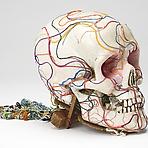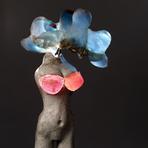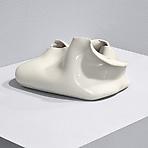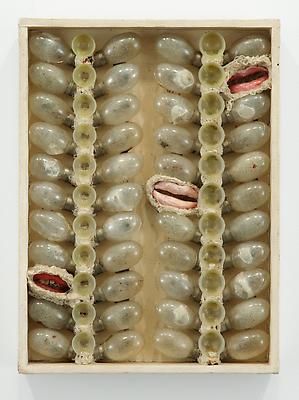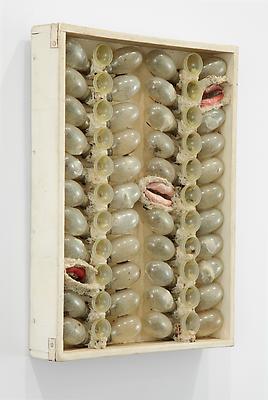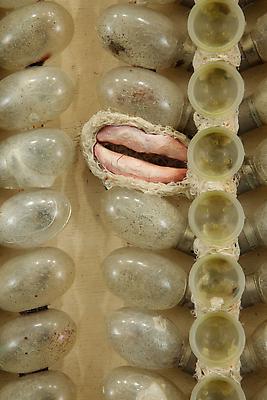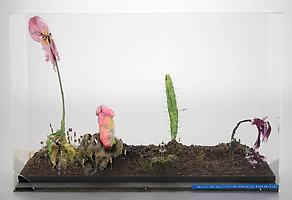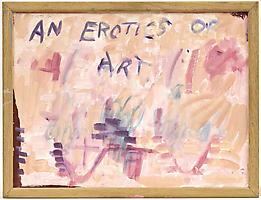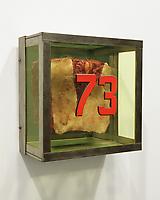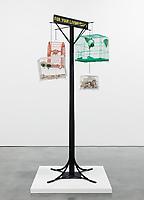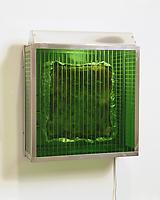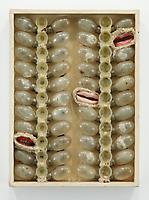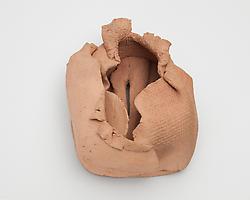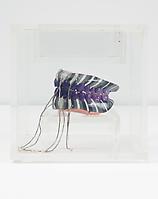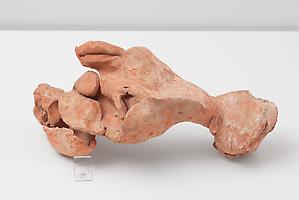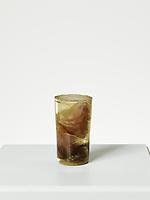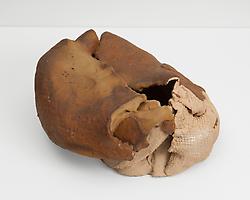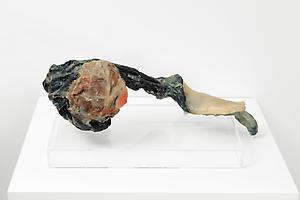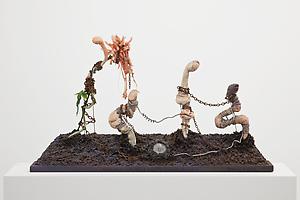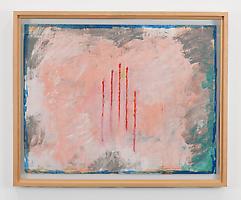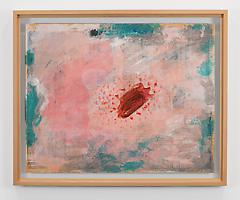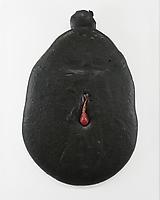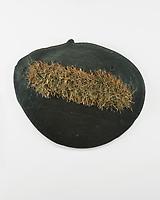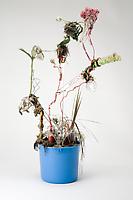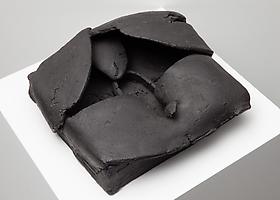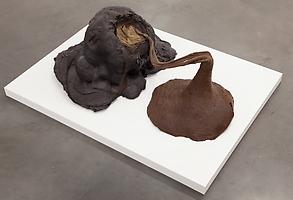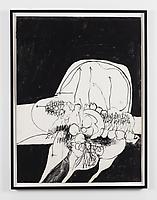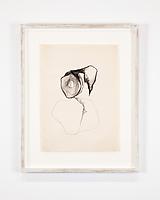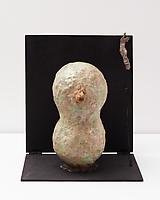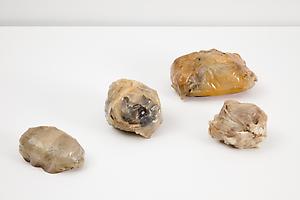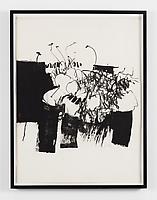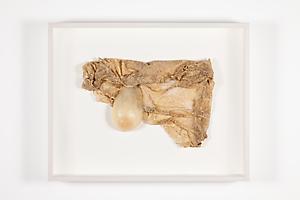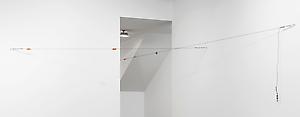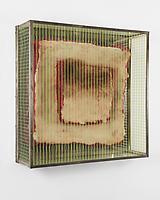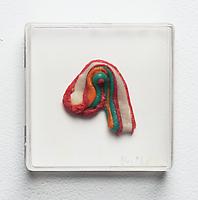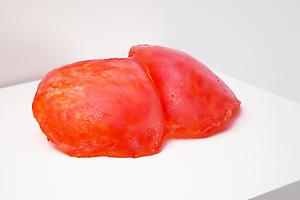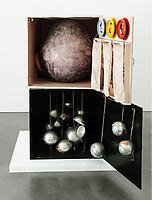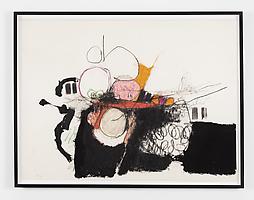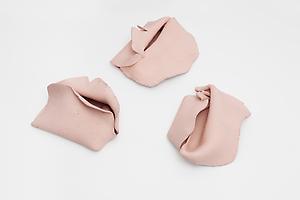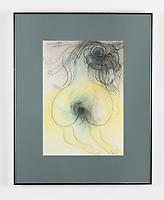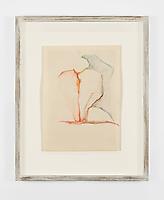Counter Forms
Tetsumi Kudo, Alina Szapocznikow, Paul Thek, Hannah Wilke. Curated by Elena Filipovic
October 12 – November 16, 2013
Main Gallery
-
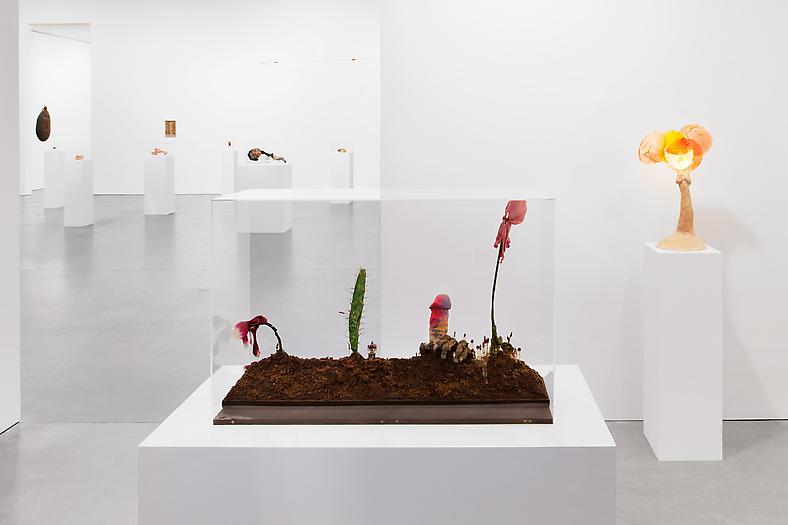
-
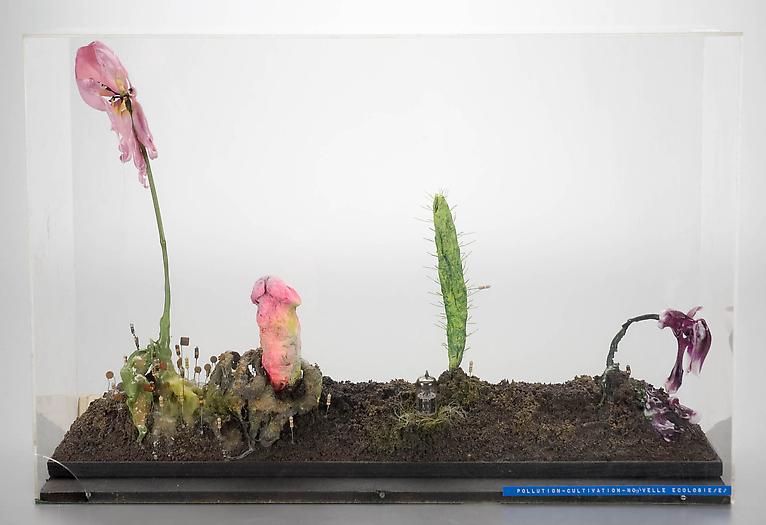
TETSUMI KUDO
Pollution – Cultivation – Nouvelle Ecologie – E -
1971
Mixed Media
17 7/8 x 26 5/8 x 9 9/16 inches (45.4 x 67.6 x 24.3 cm)
ARG# KT1971-012
© ADAGP, Paris & ARS, New York. Courtesy of Hiroko Kudo -
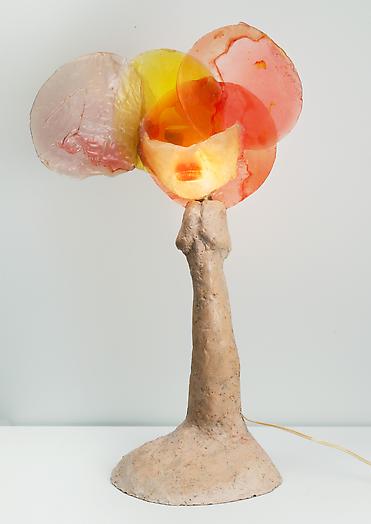
ALINA SZAPOCZNIKOW
Lampe-sculpture
circa 1970
Tinted polyester resin, light bubble and power supply cable
24.02 x 13.58 inches (61 x 34.5 cm)
ARG# SZA1970-006© The Estate of Alina Szapocznikow – ADAGP Paris
-
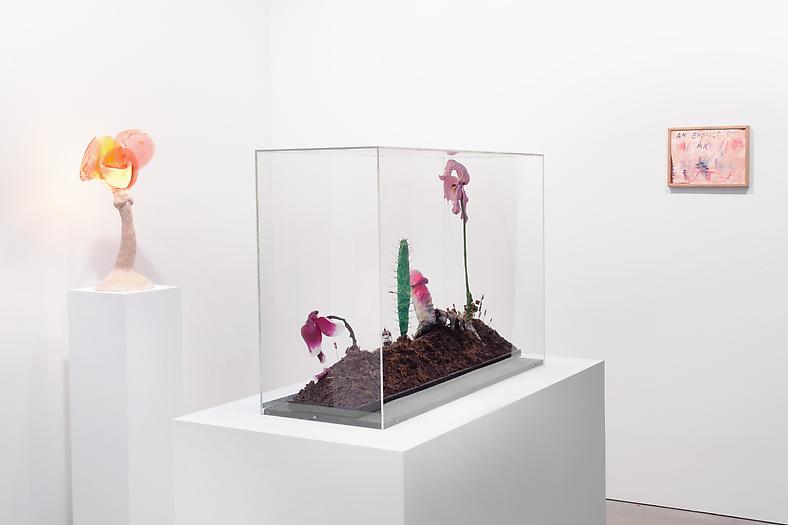
-
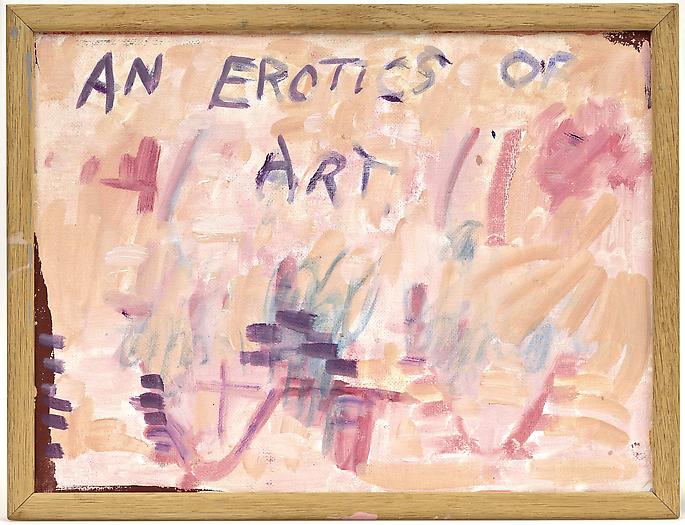
PAUL THEK
An Erotics of Art
1987
Acrylic on canvas board
9 7/8 x 12 7/8 inches (25.1 x 32.7 cm)
ARG# THP1987-002© Estate of George Paul Thek
-
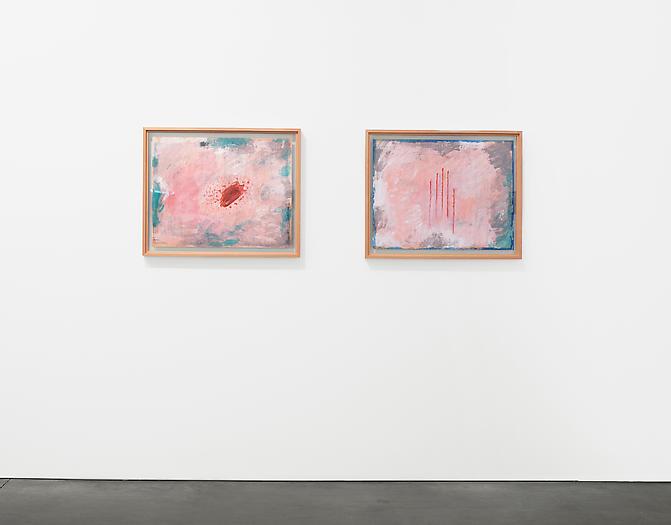
-
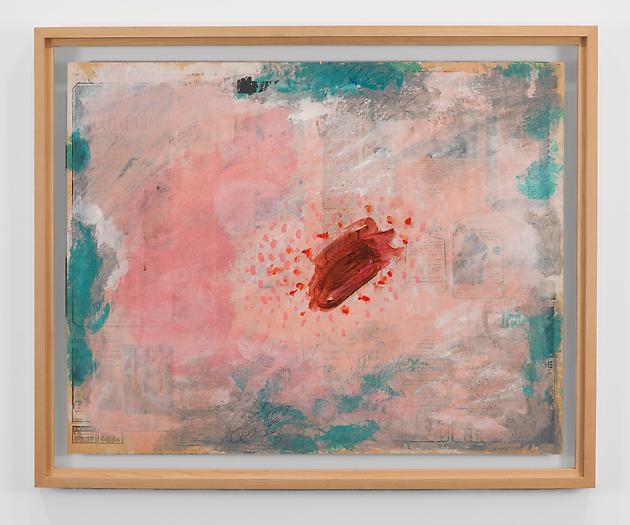
PAUL THEK
Untitled (Brown Splotch)
c. 1981
Acrylic on newspaper
22 3/8 x 28 3/8 inches (56.8 x 72.1 cm)
ARG# THP1981-002© Estate of George Paul Thek
-

PAUL THEK
Untitled (Five Vertical Red Lines)
1981
Acrylic and gesso on newspaper
22 3/8 x 28 7/8 inches (56.8 x 73.3 cm)
ARG# THP1981-001© Estate of George Paul Thek
-
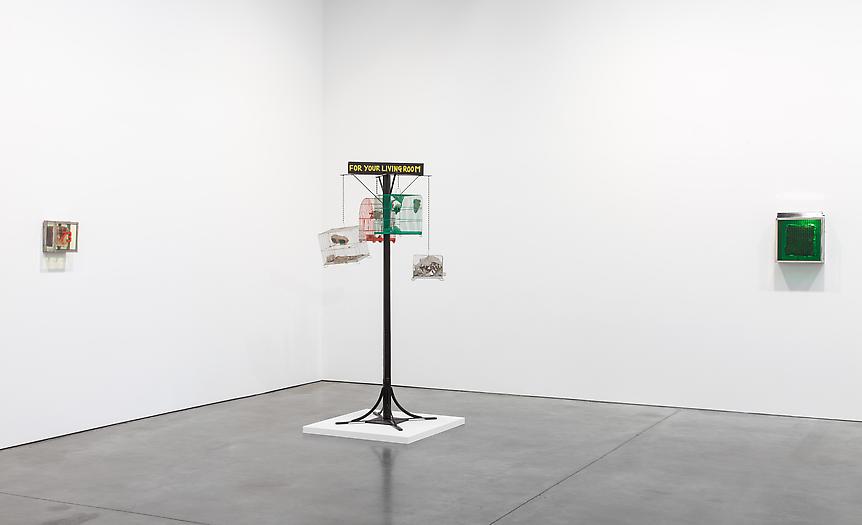
-
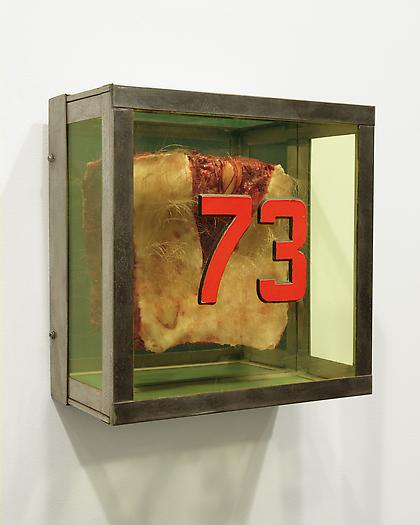
PAUL THEK
Untitled (#73)
from the series Technological Reliquaries
1964
max, metal, wood, paint, hair, cord, resin, and glass
9 1/2 x 9 1/8 x 4 5/8 inches (24.1 x 23.2 x 11.7 cm)
ARG# THP1964-010© Estate of George Paul Thek
-
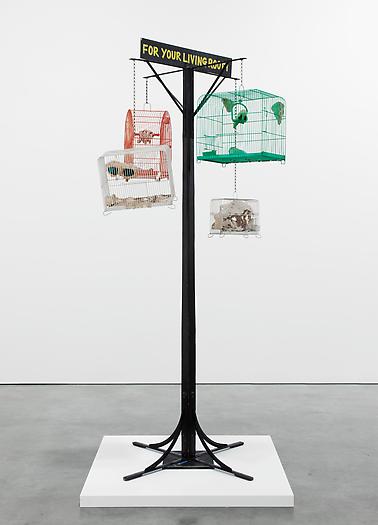
TETSUMI KUDO
for nostalgic purposes, for your living-room, souvenir “la mue”
1965-66
mixed media (cages, plastic, polyester, paint)
78.74 x 39.37 x 39.37 inches (200 x 100 x 100 cm)
ARG# KT1966-011© ADAGP, Paris & ARS, New York. Courtesy of Hiroko Kudo
-
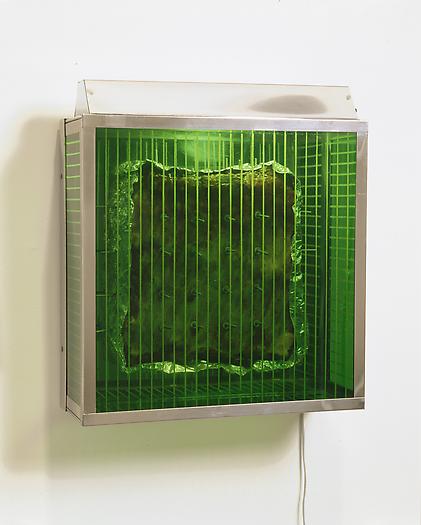
PAUL THEK
Shrine
from the series Technological Reliquaries
1967
Wax, tinfoil, steel, electric bulb, plexiglas & silkscreen
17 1/8 x 15 1/8 x 5 7/8 inches (43.5 x 38.4 x 14.9 cm)
ARG# THP1967-008© Estate of George Paul Thek
-
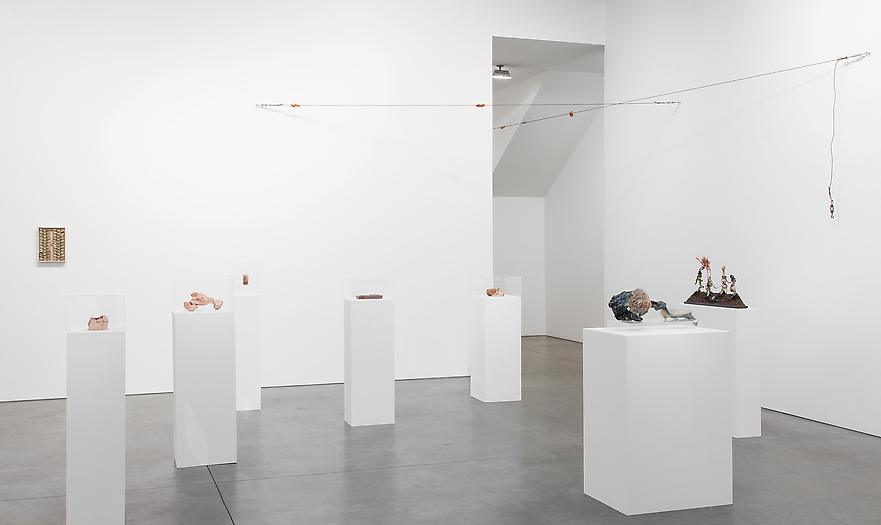
-
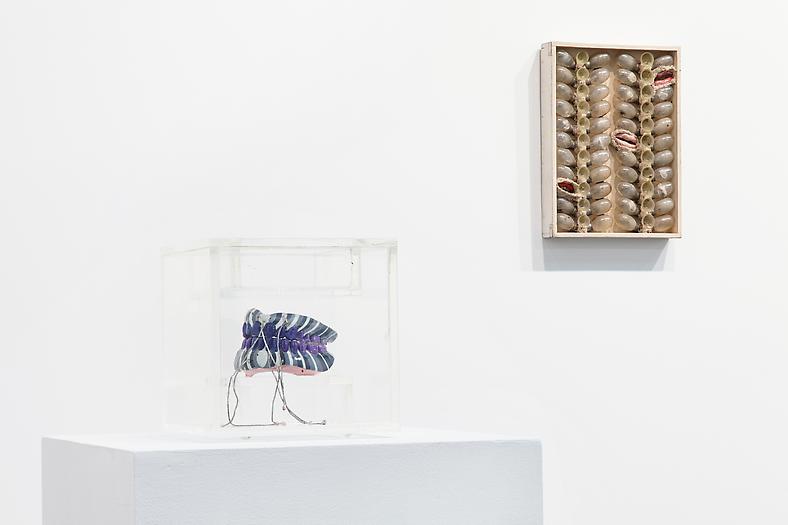
-
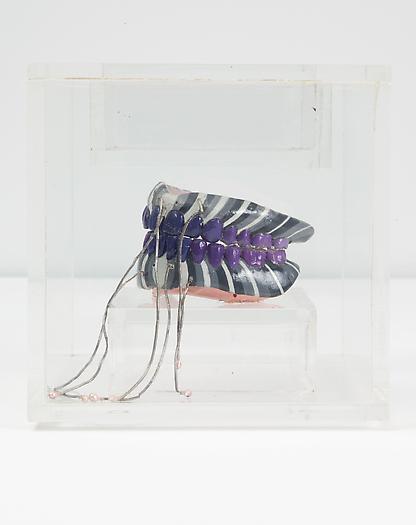
PAUL THEK
Untitled (Dental Plate #3)
from the series Technological Reliquaries
1966-67
Wood, plaster, paint, porcelain, and Plexiglas
5 1/8 x 5 x 5 1/16 inches (13 x 12.7 x 12.9 cm)
ARG# THP1967-005© Estate of George Paul Thek
-
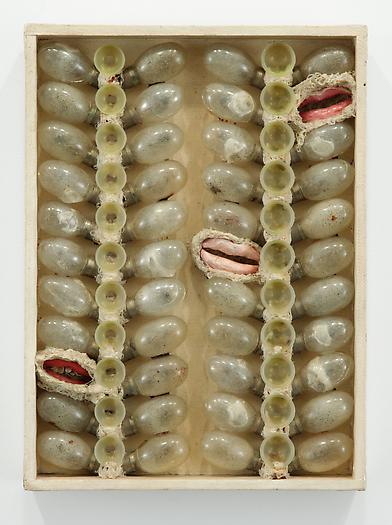
TETSUMI KUDO
Your Portrait
1963
mixed media (wood, plastic)
35 x 26 x 5 inches (88.9 x 66 x 12.7 cm)
ARG# KT1963-006© ADAGP, Paris & ARS, New York. Courtesy of Hiroko Kudo
-
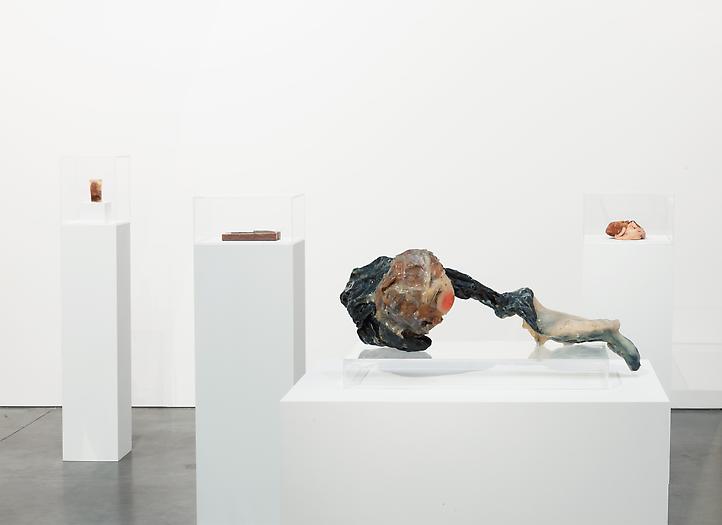
-

PAUL THEK
Untitled (Peniscast)
1964
Wax, paint, resin, hair
Height: 4.02 inches (10.2 cm)
ARG# THP1964-009© Estate of George Paul Thek
-
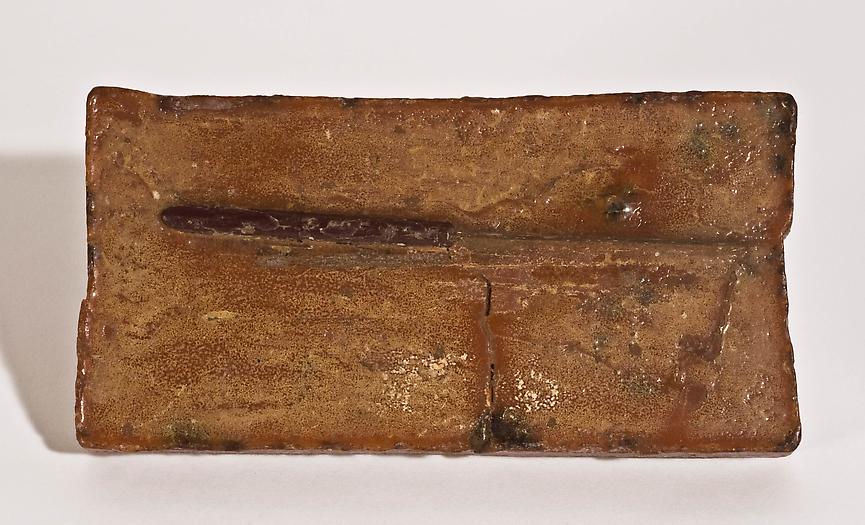
PAUL THEK
Untitled (Knife)
c. 1966
knife in wax
8 1/4 x 4 1/4 x 1 1/4 inches
(21 x 10.8 x 3.2 cm)
ARG# THP1966-012© Estate of George Paul Thek
-
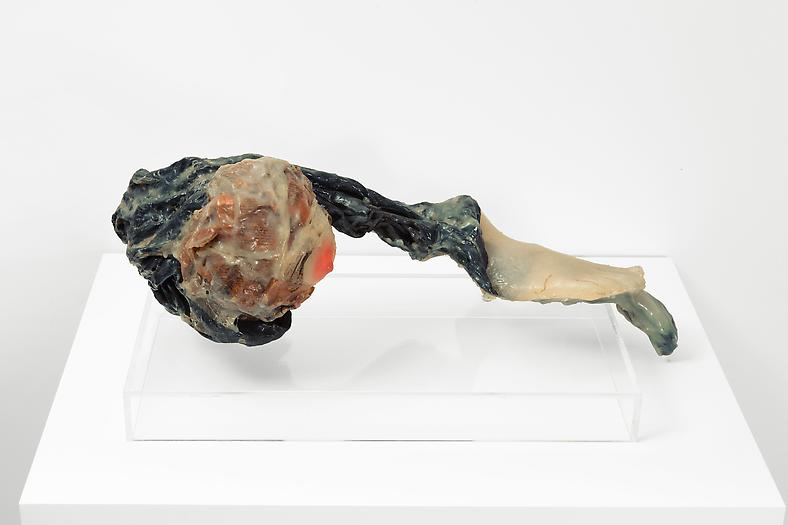
ALINA SZAPOCZNIKOW
Le pied (Fétiche V) (Foot [Fetish V])
1971
Colored polyester resin, newspaper, nylon stockings, glass, wool, Plexiglas
10 1/2 x 23 1/2 x 10 inches(26.7 x 59.7 x 25.4 cm)
ARG# SZA1971-001© The Estate of Alina Szapocznikow – ADAGP Paris
-
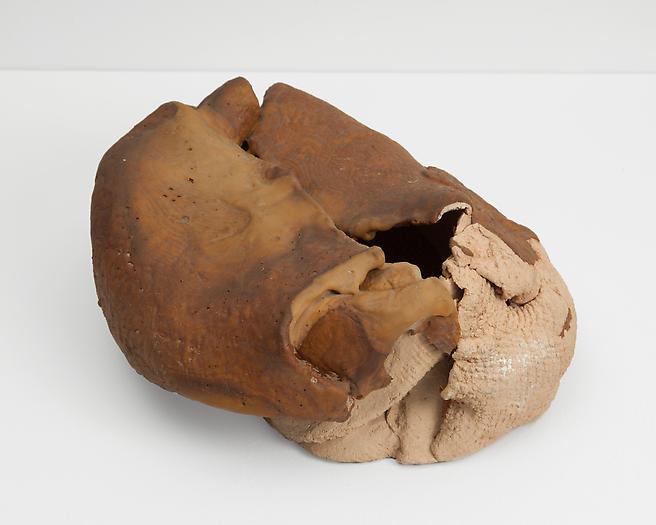
HANNAH WILKE
Untitled
c. early 1970s
Latex and terracotta
3 x 8 x 7 inches (7.6 x 20.3 x 17.8 cm)
ARG# WIH1970-012Hannah Wilke Collection & Archive, Los Angeles.
© Marsie, Emanuelle, Damon, and Andrew Scharlatt/Licensed by VAGA, New York, NY. -
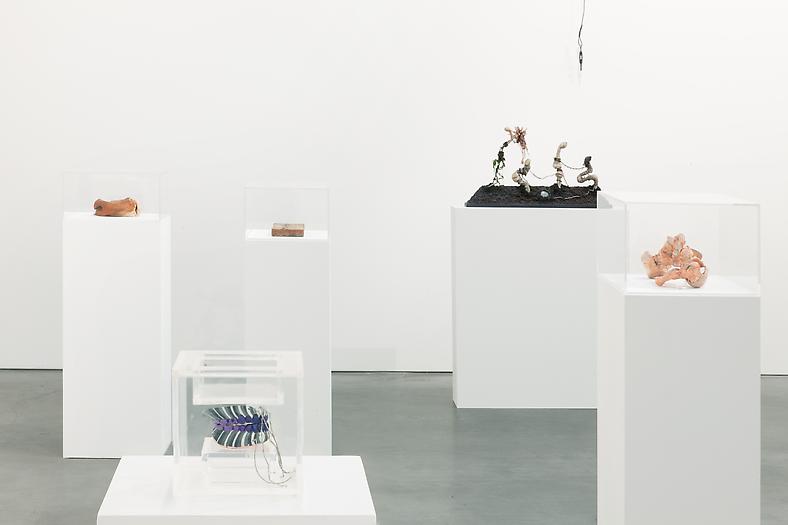
-
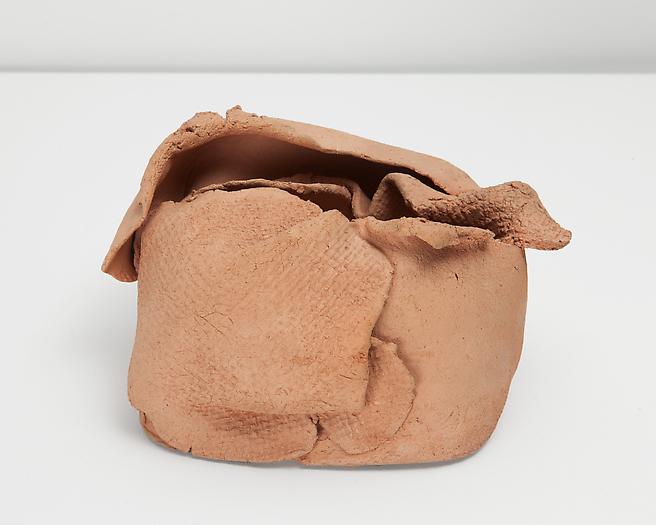
HANNAH WILKE
Untitled
c. late 1960s
Terracotta sculpture
3 1/8 x 5 1/2 x 4 inches
(7.9 x 14 x 10.2 cm)
ARG# WIH1965-004
Hannah Wilke Collection & Archive, Los Angeles. © Marsie, Emanuelle, Damon, and Andrew Scharlatt/Licensed by VAGA, New York, NY. -

TETSUMI KUDO
Human Bonsai - Freedom of Deformity - Deformity of Freedom
1979
Plastic, wood, cotton, iron, metal chains, soil, resin, thermometer, adhesive, paint
16 1/2 x 29 1/4 x 3 7/8 inches (41.9 x 74.3 x 9.8 cm)
ARG# KT1979-005© ADAGP, Paris & ARS, New York. Courtesy of Hiroko Kudo
-

ALINA SZAPOCZNIKOW
Forma II
1964-65
Unfired pink terracotta
4.53 x 7.68 x 5.12 inches (11.5 x 19.5 x 13 cm)
ARG# SZA1965-002© The Estate of Alina Szapocznikow – ADAGP Paris
-

-
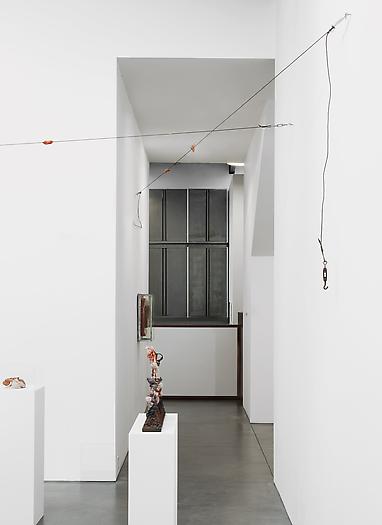
-
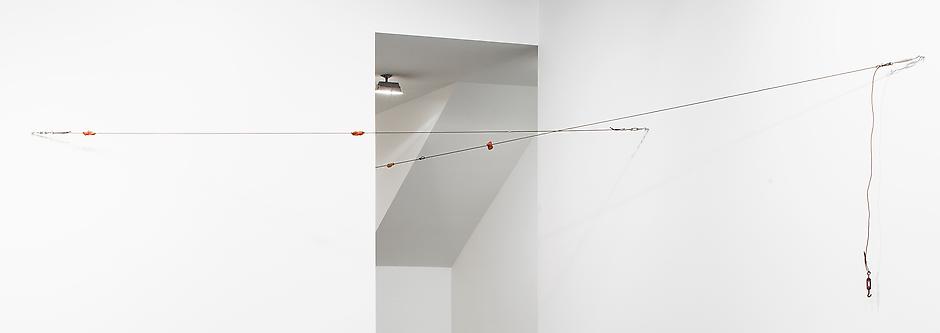
PAUL THEK
Untitled (Meat Cables)
1969
A: wax on steel cable with two turnbuckles
1 3/4 x 1 ½ 177 in/4.5 x 4 x 450 cm
B: wax on steel cable with loop, turnbuckle and bolt
2 1/2 x 2 5/8 x 370 in/6 x 6.5 x 940 cm
ARG# THP1969-005© Estate of George Paul Thek
-

PAUL THEK
Untitled
from the series Technological Reliquaries
1964
Wax, metal, wood, paint, hair, cord, resin, and glass
24 x 24 x 7 1/2 inches (61 x 61 x 19.1 cm)
ARG# THP1964-006© Estate of George Paul Thek
-
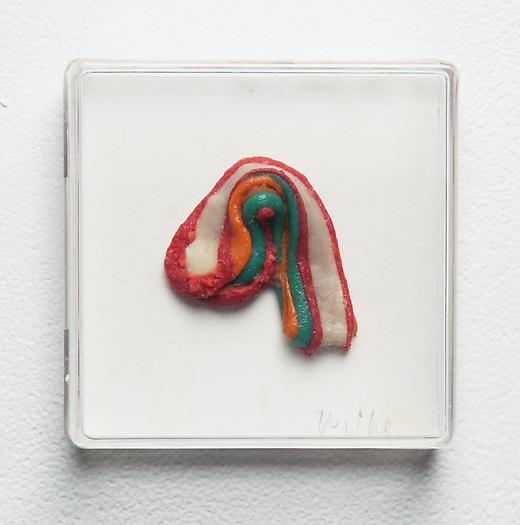
HANNAH WILKE
Untitled (Single Gum Sculpture)
c. 1975
Gum in plexiglas box
2 1/2 x 2 1/2 x 1 inches (6.4 x 6.4 x 2.5 cm)
ARG# WIH1975-011Hannah Wilke Collection & Archive, Los Angeles.
© Marsie, Emanuelle, Damon, and Andrew Scharlatt/Licensed by VAGA, New York, NY. -
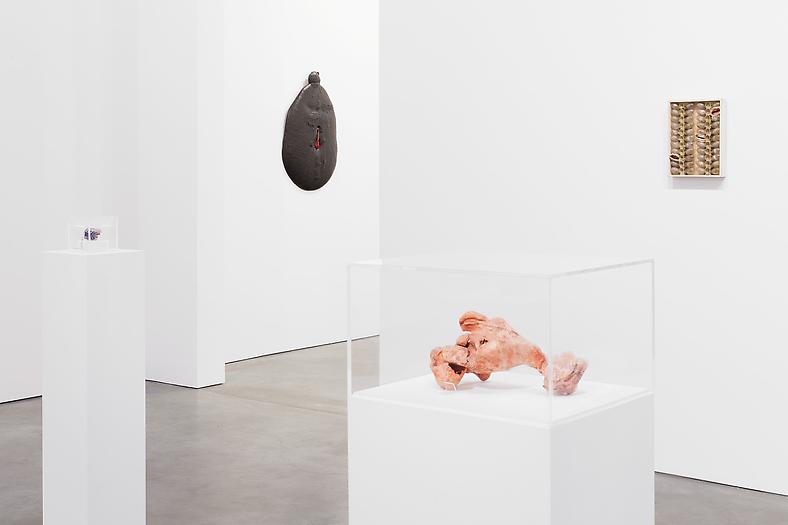
-
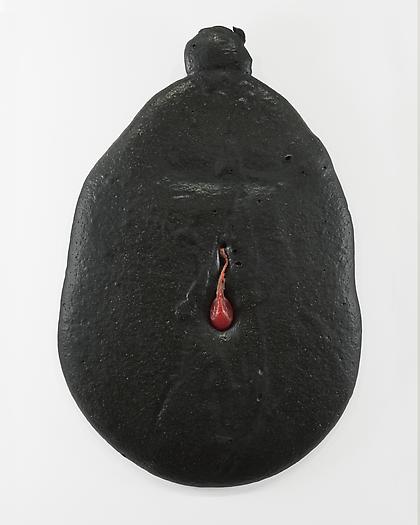
ALINA SZAPOCZNIKOW
Untitled (from the Expansion series)
1968
polyurethane foam and polyester resin
35.75 x 23.46 x 1.97 inches (90.8 x 59.6 x 5 cm)
ARG# SZA1968-002© The Estate of Alina Szapocznikow – ADAGP Paris
-
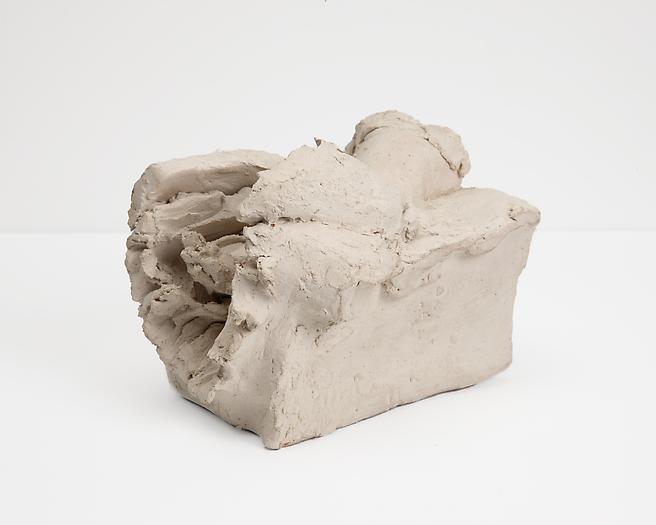
HANNAH WILKE
Untitled
c. mid to late 1960s
White terracotta
3 3/8 x 4 3/4 x 4 inches
(8.6 x 12.1 x 10.2 cm)
ARG# WIH1960-015Hannah Wilke Collection & Archive, Los Angeles.
© Marsie, Emanuelle, Damon, and Andrew Scharlatt/Licensed by VAGA, New York, NY.
-
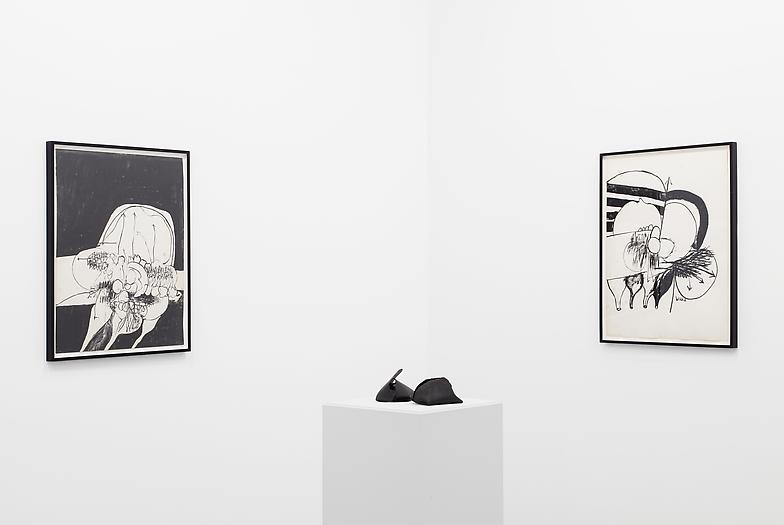
-
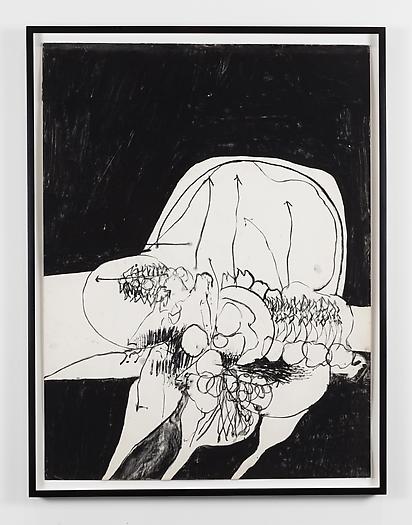
HANNAH WILKE
Untitled
c. 1960s
Charcoal and paint on paper
Artwork: 23 1/8 x 30 7/8 inches (58.7 x 78.4 cm)
Frame: 33 x 25 1/4 inches (83.8 x 64.1 cm)
ARG# WIH1960-004Hannah Wilke Collection & Archive, Los Angeles.
© Marsie, Emanuelle, Damon, and Andrew Scharlatt/Licensed by VAGA, New York, NY.
-

HANNAH WILKE
Untitled
1979
Painted bronze models for large-scale sculptures
6 x 4 1/2 x 3 1/2 inches (15.2 x 11.4 x 8.9 cm)
7 x 5 1/4 x 4 1/4 inches (17.8 x 13.3 x 10.8 cm)
ARG# WIH1979-003Hannah Wilke Collection & Archive, Los Angeles.
© Marsie, Emanuelle, Damon, and Andrew Scharlatt/Licensed by VAGA, New York, NY. -
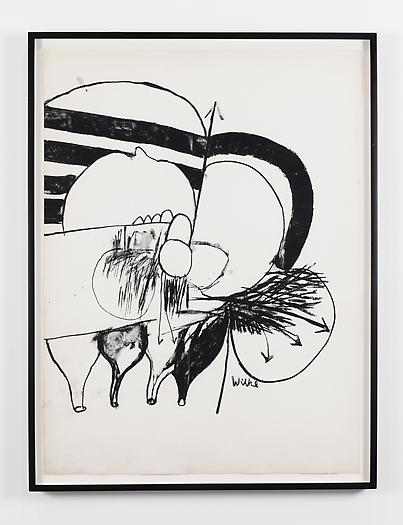
HANNAH WILKE
Untitled
c. 1960s
Charcoal on paper
Paper: 31 x 23 1/4 inches (78.7 x 59.1 cm)
Framed: 33 1/4 x 25 3/8 inches (84.5 x 64.5 cm)
ARG# WIH1960-013Hannah Wilke Collection & Archive, Los Angeles.
© Marsie, Emanuelle, Damon, and Andrew Scharlatt/Licensed by VAGA, New York, NY. -
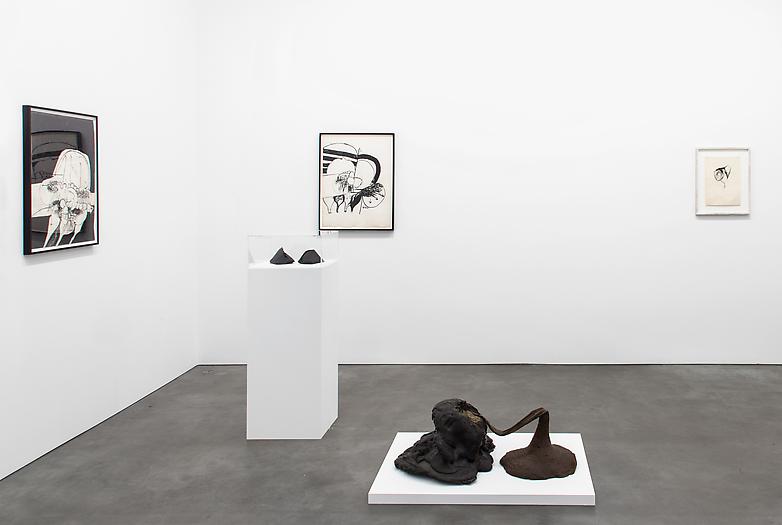
-
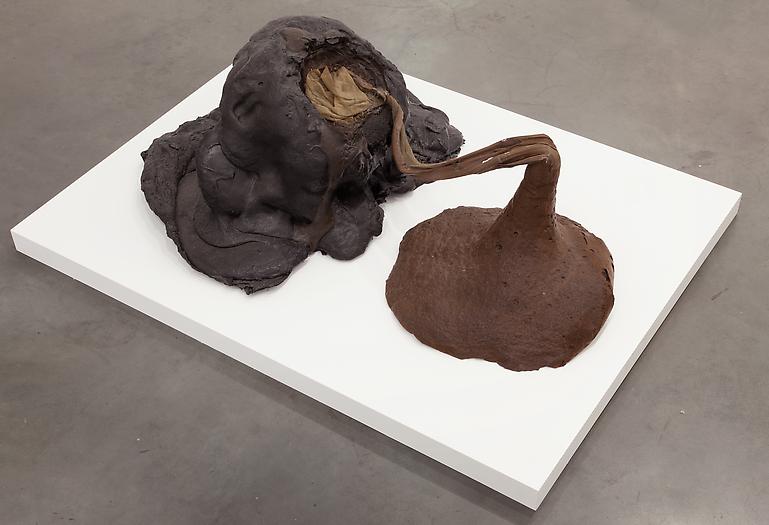
ALINA SZAPOCZNIKOW
Sous la Coupole (Under the Cupola)
1970
Polyurethane foam and nylon tights
14.17 x 28.74 x 39.37 inches (36 x 73 x 100 cm)
ARG# SZA1970-004© The Estate of Alina Szapocznikow – ADAGP Paris
-
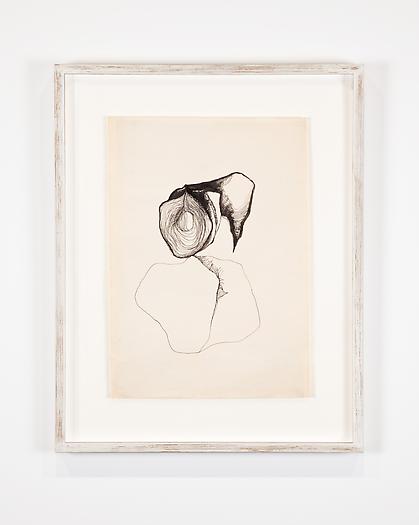
ALINA SZAPOCZNIKOW
Studium do rzeźby 5 (Study for a sculpture 5)
1963
Ink on paper
16.54 x 10.98 inches (42 x 27.9 cm)
Framed: 22.76 x 17.01 x 1.18 inches (57.8 x 43.2 x 3 cm)
ARG# SZA1963-003© The Estate of Alina Szapocznikow – ADAGP Paris
-
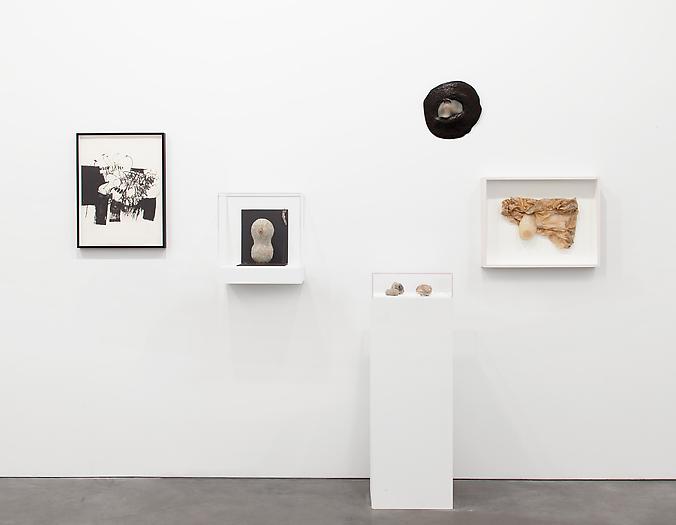
-
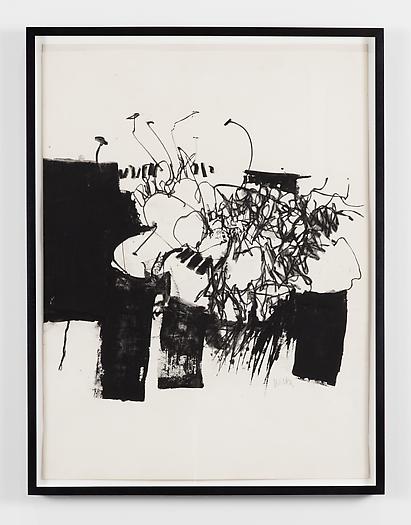
HANNAH WILKE
Untitled
1963
Charcoal on paper
Artwork: 24 x 17 3/4 inches (61 x 45.1 cm)
Frame: 25 5/8 x 19 5/8 inches (65.1 x 49.8 cm)
ARG# WIH1960-012Hannah Wilke Collection & Archive, Los Angeles.
© Marsie, Emanuelle, Damon, and Andrew Scharlatt/Licensed by VAGA, New York, NY. -
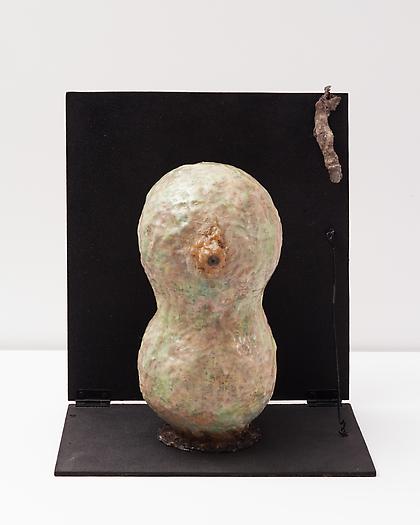
TETSUMI KUDO
You are metamorphosing
1967
mixed media
12.4 x 10.43 x 7.09 inches (31.5 x 26.5 x 18 cm)
ARG# KT1967-006© ADAGP, Paris & ARS, New York. Courtesy of Hiroko Kudo
-
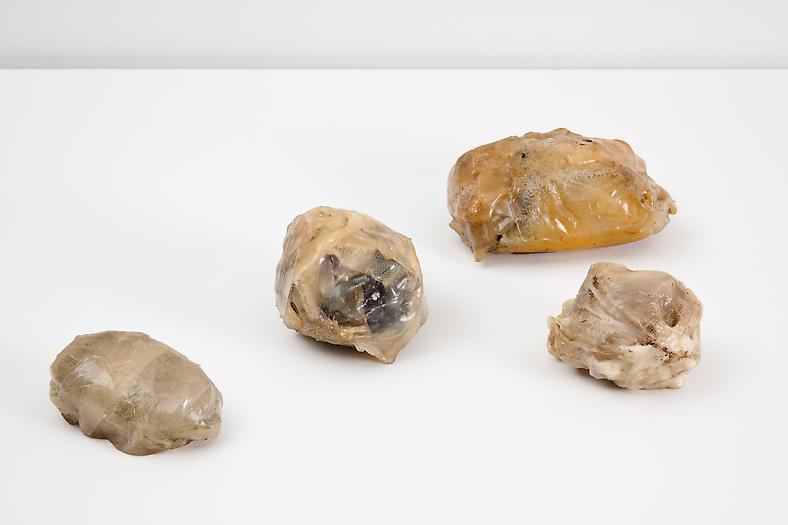
ALINA SZAPOCZNIKOW
Petite Tumeurs
1969-1970
Left to right:
Polyester resin, gauze and grass
1.38 x 3.15 x 1.97 inches (3.5 x 8 x 5 cm)
Polyester resin and gauze
2.36 x 3.35 x 2.76 inches (6 x 8.5 x 7 cm)
1.97 x 4.33 x 2.76 inches (5 x 11 x 7 cm)
1.97 x 2.76 x 2.36 inches (5 x 7 x 6 cm)© The Estate of Alina Szapocznikow – ADAGP Paris
-
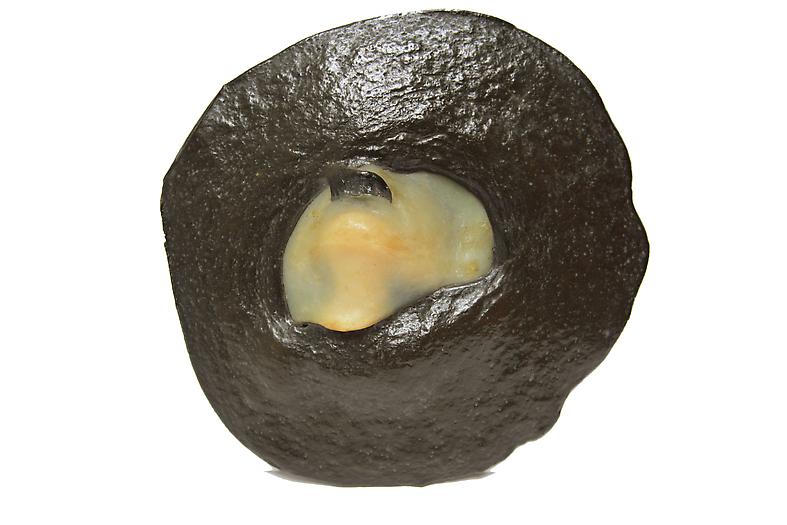
ALINA SZAPOCZNIKOW
Untitled (from the Expansion series)
c. 1968
Polyester resin and polyurethane foam
13.78 inches (35 cm)
ARG# SZA1968-012© The Estate of Alina Szapocznikow – ADAGP Paris
-
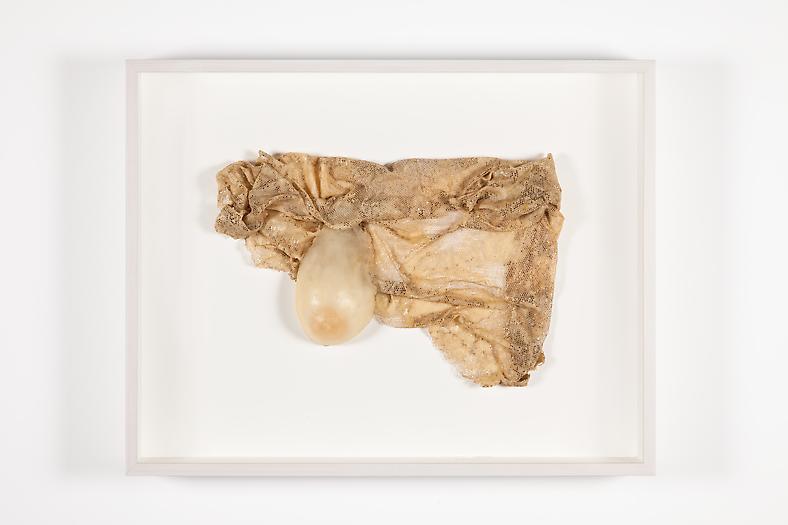
ALINA SZAPOCZNIKOW
tza (tear)
1971
Cast breast, coated polyester fabric (Polyester resin, gauze)
11.02 x 16.93 x 1.97 inches (28 x 43 x 5 cm)
ARG# SZA1971-002© The Estate of Alina Szapocznikow – ADAGP Paris
-
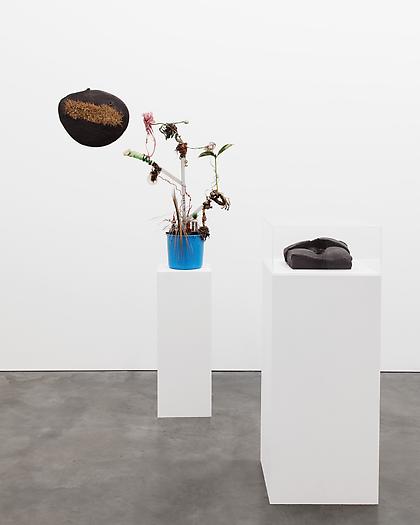
-
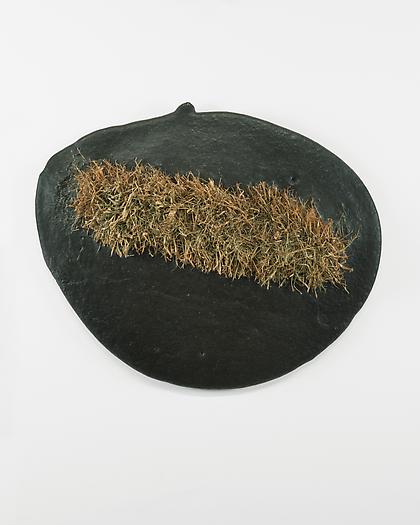
ALINA SZAPOCZNIKOW
Pollution II
1968
polyurethane foam, grass, metal
15 3/4 x 18 1/2 x 2 3/4 inches (40 x 47 x 7 cm)
ARG# SZA1968-004© The Estate of Alina Szapocznikow – ADAGP Paris
-

TETSUMI KUDO
Graft '72 (Greffe '72)
1972
Plastic, metal, soil, thermometer, wire, resin,
adhesive, paint, hair, rope
35 x 23 x 15 inches (88.9 x 58.4 x 38.1 cm)
ARG# KT1972-002© ADAGP, Paris & ARS, New York. Courtesy of Hiroko Kudo
-
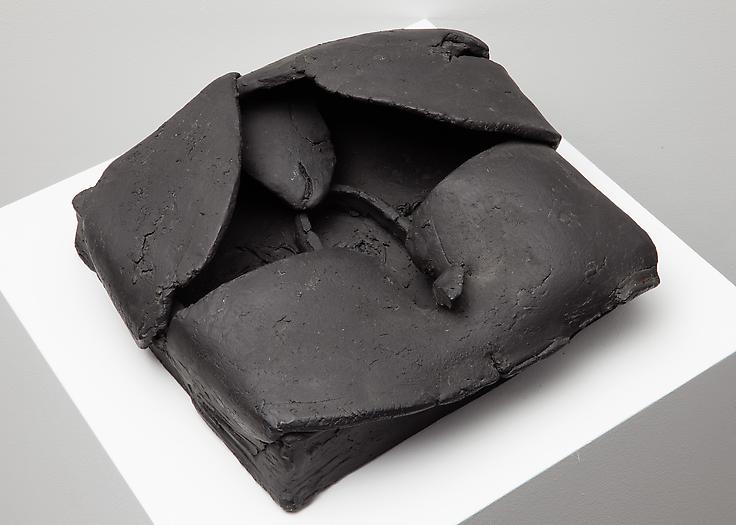
HANNAH WILKE
Untitled
c. 1960s
Painted terracotta
4 7/8 x 11 3/8 x 11 1/2 inches (12.4 x 28.9 x 29.2 cm)
ARG# WIH1960-014Hannah Wilke Collection & Archive, Los Angeles.
© Marsie, Emanuelle, Damon, and Andrew Scharlatt/Licensed by VAGA, New York, NY. -
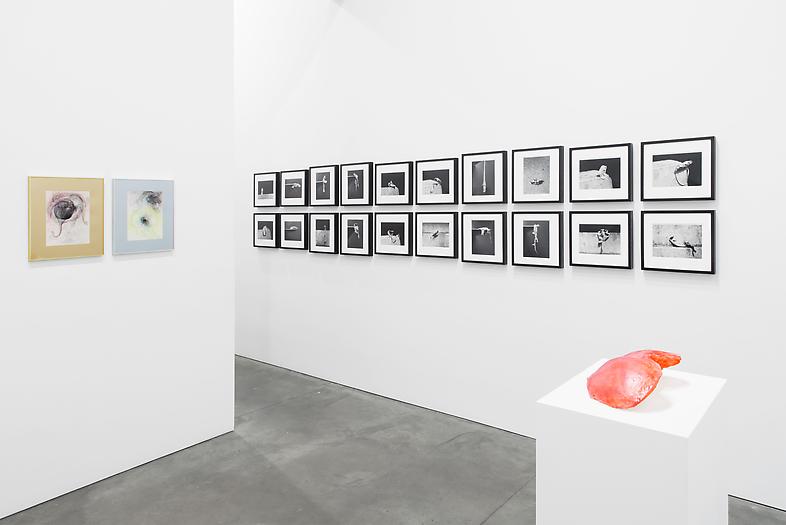
-
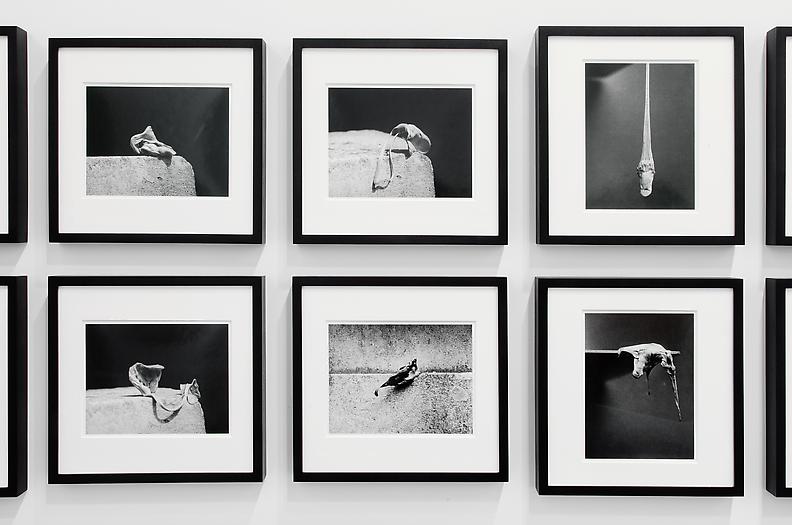
Detail of:
ALINA SZAPOCZNIKOW
Photosculptures
1971/2007
Twenty gelatin silver prints
Each: 11 13/16 x 9 7/16 inches (30 x 24 cm)
and 9 7/16 x 11 13/16 inches (24 x 30 cm)
ARG# SZA2007-001© The Estate of Alina Szapocznikow – ADAGP Paris
-
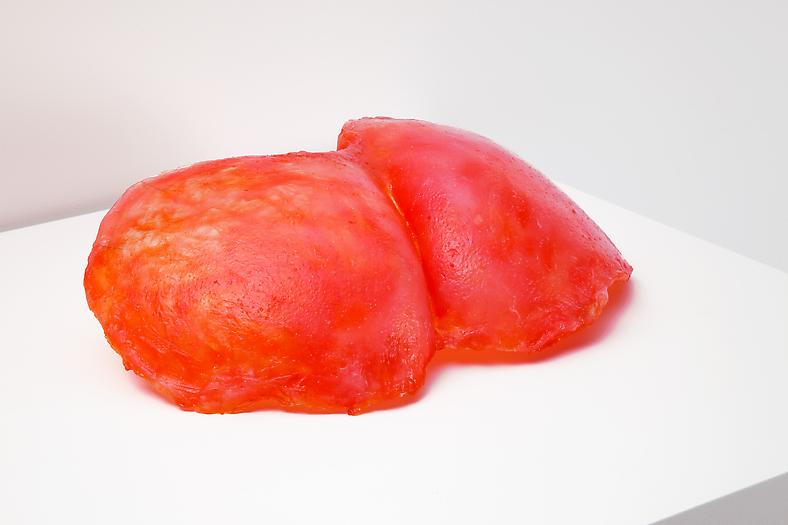
ALINA SZAPOCZNIKOW
Untitled (derrière rouge)
circa 1970-1971
colored polyester resin
3.94 x 14.57 x 8.46 inches (10 x 37 x 21.5 cm)
ARG# SZA1971-011© The Estate of Alina Szapocznikow – ADAGP Paris
-
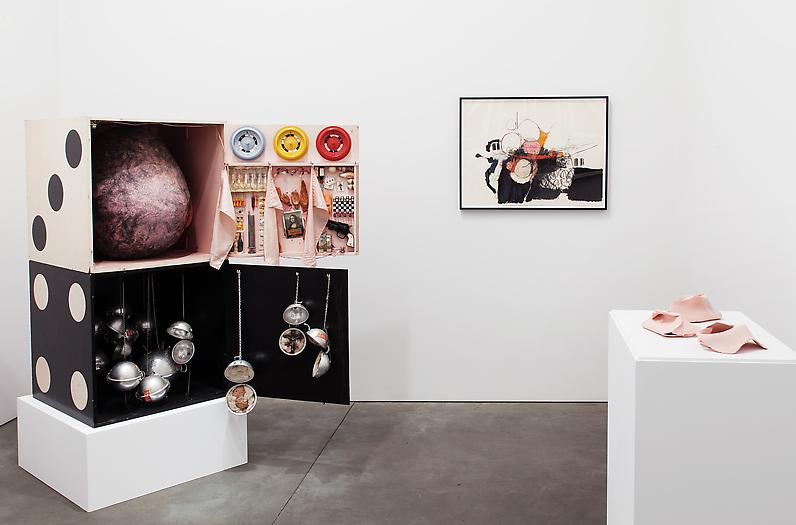
-
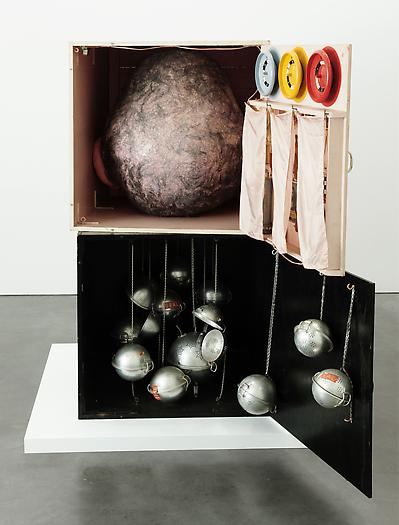
TETSUMI KUDO
Bonjour et Bonne Nuit
1963
mixed media ("hout," metal, plastic)
52.76 x 26.38 x 26.38 inches (134 x 67 x 67 cm)
ARG# KT1963-004© ADAGP, Paris & ARS, New York. Courtesy of Hiroko Kudo
-
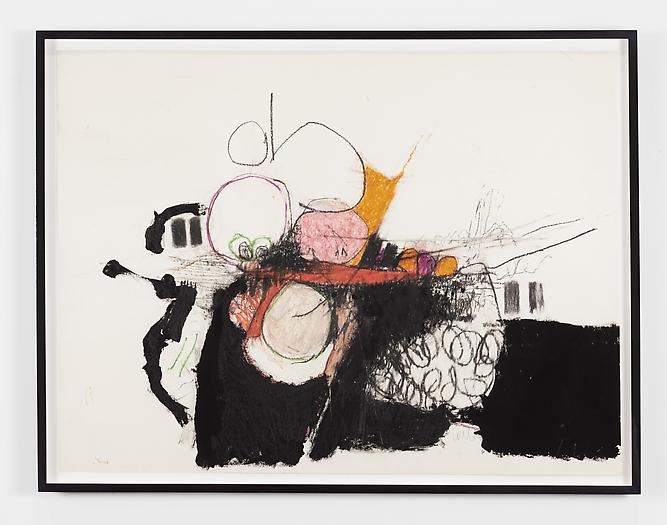
HANNAH WILKE
Untitled
c. 1960s
Charcoal and pastel on paper
Artwork: 24 3/8 x 32 1/8 inches (61.9 x 81.6 cm)
Frame: 26 1/2 x 34 3/8 inches (67.3 x 87.3 cm)
ARG# WIH1960-002Hannah Wilke Collection & Archive, Los Angeles.
© Marsie, Emanuelle, Damon, and Andrew Scharlatt/Licensed by VAGA, New York, NY. -

HANNAH WILKE
Untitled
c. early 1970s
3 painted terracotta sculptures
3 1/8 x 7 1/8 x 5 inches (7.9 x 18.1 x 12.7 cm)
2 5/8 x 6 3/4 x 5 1/2 inches (6.7 x 17.1 x 14 cm)
3 1/8 x 6 3/8 x 4 7/8 inches (7.9 x 16.2 x 12.4 cm)
ARG# WIH1970-003Hannah Wilke Collection & Archive, Los Angeles.
© Marsie, Emanuelle, Damon, and Andrew Scharlatt/Licensed by VAGA, New York, NY.
-
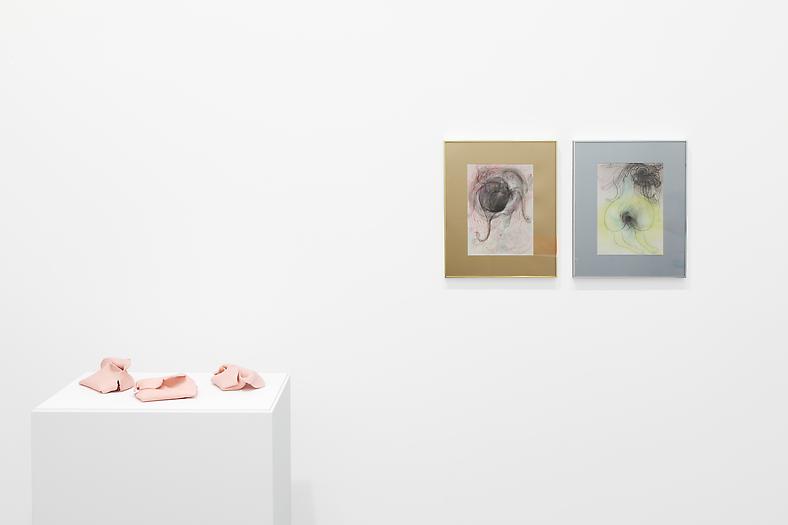
-
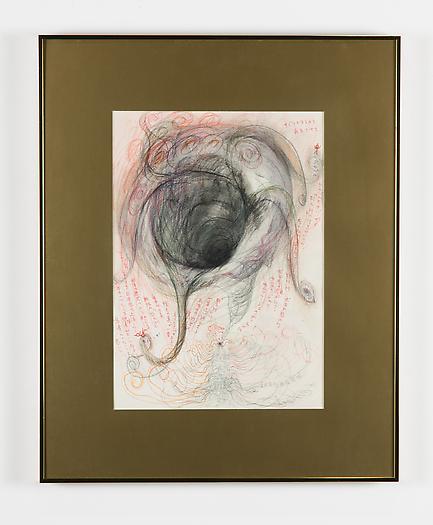
TETSUMI KUDO
Suggestion for Arrabal: The Great Ceremony
(Suggestion for Arrabal: le grand ceremonial)
1985
pastel, graphite, ink on paper
Framed: 17 5/16 x 14 inches
ARG# KT1985-014© ADAGP, Paris & ARS, New York. Courtesy of Hiroko Kudo
-
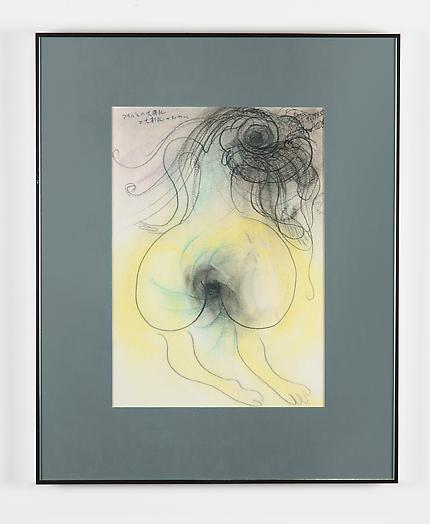
TETSUMI KUDO
Suggestion for Arrabal: The Great Ceremony
(Suggestion for Arrabal: le grand ceremonial)
1985
pastel, graphite, ink on paper
Framed: 17 5/16 x 14 inches
ARG# KT1985-006© ADAGP, Paris & ARS, New York. Courtesy of Hiroko Kudo
Counter Forms brings together an extraordinary group of rarely seen works, predominantly from the 1960s and ‘70s, by four artists whose oeuvres remains as fresh and visceral today as they must have first appeared in their time. The exhibition gathers an unprecedented constellation of artists and exceptional historical material, provoking us to look at the innovation and continuing relevance of each artist anew while also highlighting the unexpected resonance of their oeuvres. Involving many loans from institutional and private collections, archives and artists’ estates, Counter Forms continues the gallery’s commitment to featuring influential historical artists whose full significance is growing both in the United States and internationally.
During their lives, each cut too short, Tetsumi Kudo (1935-1990), Alina Szapocznikow (1926-1973), Paul Thek (1933-1988) and Hannah Wilke (1940-1993) likely never met or learned of the others’ practices. Yet in the 1960s and ‘70s they were almost simultaneously developing an art that was at once raw and sexualized, acerbic and resolutely human. Their immediate contexts were different, but whether grappling with the implications of post-war America, post-Holocaust Poland, or post-Hiroshima Japan, their works seem haunted—materially and actually—by their makers’ willing exploration of disaster and disintegration in a way that was quite at odds with the clean, optimistic and perfected forms that more widely circulated in their epoch.
Theirs was an art of bodily traces: repeatedly, obstinately, Kudo, Szapocznikow, Thek and Wilke made forms that were by turns gangly and awkward or strangely elegant, and often involving body casting or references to the body through material agglutinations of new and experimental materials of their day, including latex, resin, and poured polyurethane. The results were resolutely handmade with a charged immediacy and an aesthetic and conceptual volatility to them that far outweighed their often diminutive, human scale. Penises float in resin or sprout from buckets, delicate folds of terracotta conjure orifices both inviting and dangerous, while latex lips, butts, noses, and chins offer themselves as curious indexical traces of real bodies, figuratively dismembered. As biting as they are unexpectedly humorous, they were provocations to much sculpture being made at the time.
Intractable, unsettling, one could call them “counter forms”: decidedly not formalist exercises and yet not totally amorphous either—forms they are. In their embodied intimacy and sexual candor and in their anti-heroic stance, they offered their own uncanny riposte to the commercial imagery of Pop art, the pure geometry or industrial facture of so much Minimalism and the dry, immaterial practices of Conceptual art. Kudo, Szapocznikow, Thek and Wilke’s works spoke of the flipside of their contemporary moment’s lust for idealized commodity objects and, with it, any naively optimistic view of reality or its sexual politics. They dared to make an art so questioning that it would allow its maker “to doubt everything completely” as Kudo once wrote; an art that was imperfect, built from “awkward objects,” as Szapocznikow called hers; or, in Wilke’s words “an art close to laughter, making love, [or] shaking hands,” and which brought, as Thek explained, “the raw human fleshy characteristics back to the art” against the period’s “enormous tendency toward the minimal, the non-emotional, the anti-emotional even.”
Built around some of the shared vocabulary of these four artists, the exhibition purposefully includes rarely seen examples of Kudo’s signature cubes, buckets, gardens and cages lined with readymade objects and body cast elements that sit and protrude on stems like planted chrysanthemums; a selection of Szapocznikow’s seemingly volcanic, molten polyurethane forms, some of which were first and last shown in the late 1960s, as well as a number of examples of her penchant for body casting; a spectacular ensemble of Thek’s “Technological Reliquaries” or, “meat pieces,” wax made to resemble glistening pieces of raw flesh housed in Plexiglas cases, as well as other rarely seen of his cast works; and an extraordinary ensemble of Hannah Wilke’s early gaping, orificial forms, wrought from terracotta, ceramic, latex, bronze, or chewing gum, some never exhibited before. Their primarily sculptural practices are accented here by select examples of paintings or works on paper.
Counter Forms pays homage to a group of artists who were pushing the boundaries of what was happening in their time—formally, materially, technically, conceptually—while also sitting at the center of the critical discourse of their era. Representing their countries at the Venice Biennale, staging critically acclaimed exhibitions, receiving prestigious grants, and garnering respect from amongst their artist-colleagues, their visceral work struck a chord at the moment it was first being made and shown and then, inexplicably, slipped from many of the official narratives of the epoch. Recent reassessments have begun to importantly shift their place. Alongside such large-scale exhibitions as the 2008 Tetsumi Kudo retrospective at the Walker Art Center and forthcoming Osaka retrospective; the 2011 Alina Szapocznikow retrospective at WIELS Contemporary Art Center in Brussels, the Museum of Modern Art, the Wexner Center for the Arts, and the Hammer Museum, the large-scale drawing show at the Center Pompidou in Paris, and forthcoming monographic show at the Tel Aviv Museum of Art; the massive Thek Artist’s Artist monographic show at the 2008 ZKM, Karlsruhe and Reina Sofia, Madrid and the 2010 retrospective held at the Whitney and Hammer Museums; and the important place given to Hannah Wilke in the exhibitions Wack!, elles@ Centre Pompidou, and in the Museum of Modern Art’s most recent permanent collection display, Counter Forms contributes to a burgeoning counter narrative that makes room for a wider, messier, and perhaps more compelling history of artistic practice in the 1960s and ‘70s.
For media inquiries contact Lance Brewer at l.brewer@rosengallery.com or Mallory Testa at mallory@michellefinocchi.com
Elena Filipovic is Senior Curator at WIELS Contemporary Art Centre, Brussels. She has curated a number of traveling retrospectives, including Marcel Duchamp: A Work that is not a Work “of Art” (2008–2009), Felix Gonzalez-Torres. Specific Objects without Specific Form (2010–2011), and Alina Szapocznikow: Sculpture Undone, 1955–1972, co-curated with Joanna Mytkowska (2011–2012), in addition to organizing solo exhibitions with artists such as Leigh Ledare, Klara Lidén, Lorna Macintyre, Melvin Moti, and Tris Vonna-Michell. She was guest curator of the 14th Prix Fondation d’Entreprise Ricard, Paris (2012) and the Satellite Program at the Jeu de Paume, Paris (2010) and has, since 2007, been tutor of theory/exhibition history at De Appel postgraduate curatorial training program and advisor at the Rijksakademie in Amsterdam. Her writings have appeared in numerous artists’ catalogues as well as in Afterall, Artforum, frieze, Kaleidoscope, and Mousse.
Tetsumi Kudo was born in 1935 in Osaka, Japan and graduated from the Tokyo National University of Fine Arts in 1958. He was awarded the Grand Prize and a travel grant to Paris through his participation in the 1962 Second International Young Artists Exhibition in Tokyo. Important presentations included Venice Biennale (1976), and the Biennial São Paulo (1977, awarded a special mention) and solo exhibitions at the National Museum of Art, Osaka, the Hirosaki City Museum, Aomori, and a joint-exhibition and catalogue organized by the Van Reekum Museum and the Stedelijk Museum (1971, 1991). His work is in the collections of the Museum of Modern, Art, NY, Musée Moderne de la Ville de Paris, the Fonds National d’Art Contemporain, the Centre Georges Pompidou, and the National Museum of Art, Osaka. A major retrospective and new monograph will appear in November at the National Museum of Art, Osaka, traveling to the National Museum of Modern Art, Tokyo, and the Aomori Museum of Art.
Alina Szapocznikow was born in 1926 in Kalisz, Poland. After surviving three concentration camps during WWII, she trained at studios in Prague and the École des Beaux-arts in Paris. She first began showing her work in 1950 and held her first two-person show at the National Gallery of Art, Warsaw, in 1957. She moved to in Paris 1962, which remained her home until her death in 1973 at the age of 47. Important solo exhibitions include those at the Musée d'Art Moderne de la Ville de Paris, the Stedelijk Museum, Amsterdam, Kunsthalle Basel, Camden Arts Centre, London, and the National Museum of Warsaw. In 2012, her retrospective Alina Szapocznikow: Sculpture Undone, 1955–1972 was shown at WIELS Contemporary Art Centre, Brussels and traveled to the Museum of Modern Art, New York, the Wexner Center for the Arts, Minneapolis, and the Hammer Museum, Los Angeles. Her work is in the public collections of the Museum of Modern Art, New York, Centre Pompidou, Paris, the Tate Collection, London, the Hammer Museum, Los Angeles, and the Museum of Contemporary Art, Los Angeles, as well as numerous institutions across Poland and Western Europe.
Paul Thek was born in Brooklyn in 1933. He studied at the Art Students League, the Pratt Institute, and Cooper Union School of Art in the early 1950s. In 1954, Thek moved to Miami and first exhibited his works in 1957 at Mirrel Gallery. He was the recipient of the Fullbright Fellowship in 1967 and National Endowment for the Arts Grant in 1976. Thek’s work has been shown at numerous exhibitions internationally, including The Arts Club of Chicago, The Corcoran Gallery of Art, P.S.1 Center for Contemporary Art, Palais de Tokyo, Tate Gallery, Stedelijk Museum, and Moderna Museet. From 2010 through 2011, his retrospective traveled from the Whitney Museum of American Art to the Carnegie Museum of Art and the Hammer Museum. His work is in the collections of major American and European institutions, including the Museum of Modern Art, New York, the Whitney Museum of American Art, the Los Angeles County Museum of Art, the Hirshhorn Museum, the Walker Art Center, Centre Pompidou, and the Ludwig Museum.
Hannah Wilke was born in New York City in 1940 and trained at the Tyler School of Fine Arts at Temple University, Philadelphia. She began exhibiting in 1961 and primarily worked in New York City, where she taught at the School of Visual Arts from 1972-1991. She was the recipient of the 1982 John Simon Guggenheim Memorial Foundation Fellowship in Sculpture, as well as three National Endowment for the Arts grants for performance and sculpture and two Pollock-Krasner Grants. Select retrospectives of her work include University of Missouri (1989), Neuberger Museum, Purchase, NY, (2009)and Nikolaj Contemporary Art Center, Copenhagen (1998). Key museum presentations include the first Whitney Biennial (1972), Los Angeles County Museum of Art, the New Museum, Metropolitan Museum of Art, National Portrait Gallery, Washington, D.C., the Art Institute of Chicago, Centre Pompidou, and Museum Ludwig, Cologne. In 2011, the Museum of Modern Art, New York devoted a gallery in the permanent collection solely to her work, including drawings, latex sculpture, assemblage, and video. Wilke’s work is included in major public collections including the Whitney Museum of American Art; the Guggenheim Museum, New York; Yale University Art Gallery; the Los Angeles County Museum of Art; Museum of Contemporary Art, Los Angeles; Tate Gallery; Centre Pompidou; the Reina Sofia Museum; the Helsinki City Art Museum, and the Tokyo Metropolitan Museum of Photography.
Alina Szapocznikow: Body Traces
Jewish sculptor and proto-feminist Alina Szapocznikow (1926, Kalisz– 1973, Paris) was one of Poland’s outstanding post-WWII artists. Within two decades, she exchanged the language of classical sculpture with an idiosyncratic lexicon of new shapes, unusual materials, processes and themes that held a dialogue with the contemporary art scene and her own biography. Szapocznikow expanded the definition of sculpture in a deconstructive process of trial and error, while casting parts of her own body directly: an indexical imprint that testifies to the body’s deterioration.
This catalogue is published on the occassion of the exhibition Alina Szapocznikow: Body Traces at the Tel Aviv Museum of Art, February 7 - May 31, 2014.
Publisher: Tel Aviv Museum of Art, 2014
Paperback, 159 p., 100 ill., 70 colour, Hebrew/English
ISBN: 978-965-539-085
Alina Szapocznikow: Sculpture Undone, 1955-1972
A sculptor who began working during the postwar period in a classical figurative style, Alina Szapocznikow radically reconceptualized sculpture as an imprint not only of memory but of her own body. Though her career effectively spanned less than two decades (cut short by the artist’s premature death in 1973 at age 47), Szapocznikow left behind a legacy of provocative objects that evoke Surrealism, Nouveau Réalisme and Pop art. Her tinted polyester casts of body parts, often transformed into everyday objects like lamps or ashtrays; her poured polyurethane forms; and her elaborately constructed sculptures, which at times incorporated photographs, clothing or car parts, all remain as wonderfully idiosyncratic and culturally resonant today as when they were first made. Well-known in Poland, where her work has been highly influential since early in her career, Szapocznikow’s compelling oeuvre is ripe for art-historical reexamination. Alina Szapocznikow: Sculpture Undone, 1955–1972 offers a comprehensive overview of this important artist’s work at a moment when international interest is blossoming. Richly illustrated with over 150 color plates, the catalogue features essays that touch on key aspects of her practice and historical reception, as well as an extensive annotated chronology that provides an in-depth exploration of the intersection of her life and art. Working in one of the most rich and complex periods of the twentieth century, Szapocznikow responded to many of the ideological and artistic developments of her time through artwork that is at once fragmented and transformative, sensual and reflective, playfully realized and politically charged.
Alina Szapocznikow was born in Poland in 1926, and gained critical attention there for her early sculpture of the 1950s. She re-settled permanently in France in 1963, where her continued exploration of new materials such as polyester and polyurethane brought her into dialogue with the contemporary art scene of her time. She continued to push the boundaries of sculptural form and subject matter up until her premature death in 1973.
Paperback: 216 pages
Publisher: The Museum of Modern Art, New York; annotated edition edition (January 16, 2012)
ISBN-10: 0870708244
ISBN-13: 978-0870708244
Alina Szapocznikow: From Drawing into Sculpture
One of the first to use materials such as polyurethane foam and polyester resin, Alina Szapocznikow (1926–1973) is a renowned artist in her native country of Poland, and has been the subject of increased interest in the U.S, following her 2012 touring retrospective. Though she is better known for her sculptures, Szapocznikow’s drawings are equally unique and fascinating. Felt-tip, ballpoint, crayons, ink, watercolor and monotype were her materials of choice in the medium. Forty years after her death, they are now being rediscovered by scholars and museums worldwide. The works showcased in this book reveal the depth of Szapocznikow’s fantasy, the originality of her reflections on the body, as well as highlighting her humor, sexuality and exuberance. These drawings reflect the distinctive style of an artist who can be considered an heir to the Surrealists and a precursor to the Pop movement.
Hardcover: 184 pages
Publisher: Editions Dilecta (September 30, 2013)
ISBN-13: 979-1090490291
ASIN: B00AENY5JK
After-affects / After-images: Trauma and Aesthetic Transformation in the Virtual Feminist Museum
Do artists travel away from or towards trauma?
Is trauma encrypted or inscribed in art?
Or can aesthetic practices – after-images – bring about transformation – that does not imply cure or resolution – of the traces – after-affects – of trauma, personal trauma or historical traumas inhabiting the world whose traces artists also process as participants in and sensors for our life-worlds and histories? How does the viewer, coming belatedly or from elsewhere encounter works bearing such traces or seeking forms through which to touch and transform them?
These are some of the questions posed by major feminist art historian and cultural analyst, Griselda Pollock, in her latest installation of the virtual feminist museum. In closely-read case studies, we encounter artworks by Gian Lorenzo Bernini, Ana Mendieta, Louise Bourgeois, Alina Szapocznikow, Anna Maria Maiolino, Vera Frenkel, Sarah Kofman and Chantal Akerman to explore trauma and bereavement, fatal illness, first and second generation Holocaust experience, migration, exile and the encounter with political horror and atrocity. Offering a specifically feminist contribution to trauma studies, and a feminist psychoanalytical contribution to the study of contemporary art, this volume continues the conceptual innovations that have been the hall-mark of Pollock's dedicated exploration of 'feminist interventions in art's histories'.
Griselda Pollock is Professor of Social and Critical Histories of Art and Director of the Centre for Cultural Analysis, Theory and History at the University of Leeds.
Paperback: 384 pages
Publisher: Manchester University Press (October 22, 2013)
ISBN-10: 0719087988
ISBN-13: 978-0719087981
Hannah Wilke
The first monograph on an artist whose provocative and ultimately deeply moving work played an essential part in women's transformation of the art world. Hannah Wilke's artwork, like her life, frames a heroic story about formal invention and social activism, personal loyalties and individual freedom, and, above all, breathtaking risk. A defining presence in the emerging community of women artists in the 1960s and 70s, Wilke developed a unique and controversial visual language in response to her own and women s experience. An unapologetic individualist, she celebrated her relationships with men as well as women and frankly explored the pleasures of sexuality. Using a wide range of nontraditional mediums, including latex and chewing gum as well as photography and film, she irreverently paid tribute to predecessors from Marcel Duchamp to David Smith. Focusing on the body as instrument and object of visual expression. Wilke's art is inseparable from Wilke the person: bold, sometimes outrageous, and, ultimately, heartbreakingly courageous.
Hardcover: 168 pages
Publisher: Prestel (May 20, 2010)
ISBN-10: 3791339729
ISBN-13: 978-3791339726
Hannah Wilke: Gestures
The act of folding is the salient gesture in the sculptures of American artist Hannah Wilke (1940-1993). Taking such materials as clay, bubble gum and Play-Doh, Wilke fashioned serial forms that folded inward or opened out with overtly labial sensuousness. Wilke often placed these objects in compromising situations--hinged with pins or glued to walls and boards, placed freely on the floor, always seemingly on the verge of disaster. Today she is famed for her many nude self-portraits, which have threatened to eclipse the sculptural basis of both the portraits themselves and her work in general. By emphasizing folding as a gesture, this catalogue--the first on the artist to appear in many years--unites Wilke's sculpture and photography under the rubric of performance, and the performing of material. With an abundance of color reproductions and critical commentary, Hannah Wilke: Gestures offers a fresh assessment of a pioneer in sculpture, feminist art and performance.
Paperback: 108 pages
Publisher: Neuberger Museum of Art; 1 edition (August 30, 2010)
ISBN-10: 0979562929
ISBN-13: 978-0979562921
Hannah Wilke: A Retrospective
Published on the occassion of the retrospective exhibition held at Gallery 210,
University of Missouri, St. Louis, April 3 - 28, 1989.
For Hannah Wilke, the point of departure was always the body and its discontinuous relationship with language. In the 1970s, Wilke’s work-particularly the way that she used the body in her artistic practices-was considered controversial by many feminist critics. Today, however, when theoretical and artistic strategies have changed and when art is increasingly cognizant of social context, Wilke’s work has found rightful place among the most important artwork of the past thirty years. This catalogue presents a unique survey of Wilke’s oeuvre, with reproductions of her videos and films four essays focusing on different aspects of her life and work, including a detailed biography, and a selected biography, a complete list of her works and an exhibition checklist.
Hardcover: 168 pages
Publisher: University of Missouri Press (July 31, 1989)
ISBN-10: 0826207030
ISBN-13: 978-0826207036
TETSUMI KUDO
Your Portrait
1963
mixed media (wood, plastic)
35 x 26 x 5 inches
(88.9 x 66 x 12.7 cm)
ARG# KT1963-006
© ADAGP, Paris & ARS, New York
Courtesy of Hiroko Kudo
TETSUMI KUDO
Pollution – Cultivation – Nouvelle Ecologie – E-
1971
Mixed Media
17 7/8 x 26 5/8 x 9 9/16 inches
(45.4 x 67.6 x 24.3 cm)
ARG# KT1971-012
© ADAGP, Paris & ARS, New York
Courtesy of Hiroko Kudo
ALINA SZAPOCZNIKOW
Lampe-sculpture
circa 1970
Tinted polyester resin, light bubble and power
supply cable
24.02 x 13.58 inches
(61 x 34.5 cm)
ARG# SZA1970-006
© The Estate of Alina Szapocznikow – ADAGP Paris
PAUL THEK
An Erotics of Art
1987
Acrylic on canvas board
9 7/8 x 12 7/8 inches
(25.1 x 32.7 cm)
ARG# THP1987-002
© Estate of George Paul Thek
PAUL THEK
Untitled (#73)
from the series Technological Reliquaries
1964
max, metal, wood, paint, hair, cord, resin, and glass
9 1/2 x 9 1/8 x 4 5/8 inches
(24.1 x 23.2 x 11.7 cm)
ARG# THP1964-010
© Estate of George Paul Thek
TETSUMI KUDO
for nostalgic purposes, for your living-room,
souvenir “la mue”
1965-66
mixed media (cages, plastic, polyester, paint)
78.74 x 39.37 x 39.37 inches
(200 x 100 x 100 cm)
ARG# KT1966-011
© ADAGP, Paris & ARS, New York
Courtesy of Hiroko Kudo
PAUL THEK
Shrine
from the series Technological Reliquaries
1967
Wax, tinfoil, steel, electric bulb, plexiglas & silkscreen
17 1/8 x 15 1/8 x 5 7/8 inches
(43.5 x 38.4 x 14.9 cm)
ARG# THP1967-008
© Estate of George Paul Thek
TETSUMI KUDO
Your Portrait
1963
mixed media (wood, plastic)
35 x 26 x 5 inches
(88.9 x 66 x 12.7 cm)
ARG# KT1963-006
© ADAGP, Paris & ARS, New York
Courtesy of Hiroko Kudo
HANNAH WILKE
Untitled
c. late 1960s
Terracotta sculpture
3 1/8 x 5 1/2 x 4 inches
(7.9 x 14 x 10.2 cm)
ARG# WIH1965-004
Hannah Wilke Collection
& Archive, Los Angeles.
© Marsie, Emanuelle,
Damon, and Andrew
Scharlatt/Licensed by
VAGA, New York, NY.
PAUL THEK
Untitled (Dental Plate #3)
from the series Technological Reliquaries
1966-67
Wood, plaster, paint, porcelain, and Plexiglas
5 1/8 x 5 x 5 1/16 inches (13 x 12.7 x 12.9 cm)
ARG# THP1967-005
© Estate of George Paul Thek
ALINA SZAPOCZNIKOW
Forma II
1964-65
Unfired pink terracotta
4.53 x 7.68 x 5.12 inches (11.5 x 19.5 x 13 cm)
Catalogue Raisonné n. 268
ARG# SZA1965-002
© The Estate of Alina Szapocznikow – ADAGP Paris
PAUL THEK
Untitled (Peniscast)
1964
Wax, paint, resin, hair
Height: 4.02 inches (10.2 cm)
ARG# THP1964-009
© Estate of George Paul Thek
PAUL THEK
Untitled (Knife)
c. 1966
knife in wax
8 1/4 x 4 1/4 x 1 1/4 inches
(21 x 10.8 x 3.2 cm)
ARG# THP1966-012
© Estate of George Paul Thek
HANNAH WILKE
Untitled
c. early 1970s
Latex and terracotta
3 x 8 x 7 inches (7.6 x 20.3 x 17.8 cm)
ARG# WIH1970-012
Hannah Wilke Collection
& Archive, Los Angeles.
© Marsie, Emanuelle,
Damon, and Andrew
Scharlatt/Licensed by
VAGA, New York, NY.
ALINA SZAPOCZNIKOW
Le pied (Fétiche V) (Foot [Fetish V])
1971
Colored polyester resin, newspaper, nylon
stockings, glass wool, Plexiglas
10 1/2 x 23 1/2 x 10 inches
(26.7 x 59.7 x 25.4 cm)
Catalogue raisonné n. 438
ARG# SZA1971-001
© The Estate of Alina Szapocznikow – ADAGP Paris
TETSUMI KUDO
Human Bonsai - Freedom of Deformity -
Deformity of Freedom
1979
Plastic, wood, cotton, iron, metal chains, soil,
resin, thermometer, adhesive, paint
16 1/2 x 29 1/4 x 3 7/8 inches
(41.9 x 74.3 x 9.8 cm)
ARG# KT1979-005
© ADAGP, Paris & ARS, New York
Courtesy of Hiroko Kudo
PAUL THEK
Untitled (Five Vertical Red Lines)
1981
Acrylic and gesso on newspaper
22 3/8 x 28 7/8 inches (56.8 x 73.3 cm)
ARG# THP1981-001
© Estate of George Paul Thek
PAUL THEK
Untitled (Brown Splotch)
c. 1981
Acrylic on newspaper
22 3/8 x 28 3/8 inches (56.8 x 72.1 cm)
ARG# THP1981-002
© Estate of George Paul Thek
ALINA SZAPOCZNIKOW
Untitled (from the Expansion series)
1968
polyurethane foam and polyester resin
35.75 x 23.46 x 1.97 inches
(90.8 x 59.6 x 5 cm)
Catalogue Raisonné appendix n. 13
ARG# SZA1968-002
© The Estate of Alina Szapocznikow – ADAGP Paris
HANNAH WILKE
Untitled
c. mid to late 1960s
White terracotta
3 3/8 x 4 3/4 x 4 inches
(8.6 x 12.1 x 10.2 cm)
ARG# WIH1960-015
Hannah Wilke Collection
& Archive, Los Angeles.
© Marsie, Emanuelle,
Damon, and Andrew
Scharlatt/Licensed by
VAGA, New York, NY.
ALINA SZAPOCZNIKOW
Pollution II
1968
polyurethane foam, grass, metal
15 3/4 x 18 1/2 x 2 3/4 inches (40 x 47 x 7 cm)
Catalogue Raisonné n. 387
ARG# SZA1968-004
© The Estate of Alina Szapocznikow – ADAGP Paris
TETSUMI KUDO
Suggestion for Arrabal: The Great Ceremony
(Suggestion for Arrabal: le grand ceremonial)
1985
pastel, graphite, ink on paper
Framed: 17 5/16 x 14 inches
ARG# KT1985-014
© ADAGP, Paris & ARS, New York
Courtesy of Hiroko Kudo
TETSUMI KUDO
Graft '72 (Greffe '72)
1972
Plastic, metal, soil, thermometer, wire, resin,
adhesive, paint, hair, rope
35 x 23 x 15 inches
(88.9 x 58.4 x 38.1 cm)
ARG# KT1972-002
© ADAGP, Paris & ARS, New York
Courtesy of Hiroko Kudo
HANNAH WILKE
Untitled
c. 1960s
Painted terracotta
4 7/8 x 11 3/8 x 11 1/2 inches
(12.4 x 28.9 x 29.2 cm)
ARG# WIH1960-014
Hannah Wilke Collection
& Archive, Los Angeles.
© Marsie, Emanuelle,
Damon, and Andrew
Scharlatt/Licensed by
VAGA, New York, NY.
ALINA SZAPOCZNIKOW
Sous la Coupole (Under the Cupola)
1970
Polyurethane foam and nylon tights
14.17 x 28.74 x 39.37 inches
(36 x 73 x 100 cm)
Catalogue raisonné n. 414
ARG# SZA1970-004
© The Estate of Alina Szapocznikow – ADAGP Paris
HANNAH WILKE
Untitled
1979
Painted bronze models for large-scale
sculptures
6 x 4 1/2 x 3 1/2 inches
(15.2 x 11.4 x 8.9 cm)
7 x 5 1/4 x 4 1/4 inches
(17.8 x 13.3 x 10.8 cm)
ARG# WIH1979-003
Hannah Wilke Collection
& Archive, Los Angeles.
© Marsie, Emanuelle,
Damon, and Andrew
Scharlatt/Licensed by
VAGA, New York, NY.
HANNAH WILKE
Untitled
c. 1960s
Charcoal and paint on paper
Artwork: 23 1/8 x 30 7/8 inches
(58.7 x 78.4 cm)
Frame: 33 x 25 1/4 inches
(83.8 x 64.1 cm)
ARG# WIH1960-004
Hannah Wilke Collection
& Archive, Los Angeles.
© Marsie, Emanuelle,
Damon, and Andrew
Scharlatt/Licensed by
VAGA, New York, NY.
HANNAH WILKE
Untitled
c. 1960s
Charcoal on paper
Paper: 31 x 23 1/4 inches
(78.7 x 59.1 cm)
Framed: 33 1/4 x 25 3/8 inches
(84.5 x 64.5 cm)
ARG# WIH1960-013
Hannah Wilke Collection
& Archive, Los Angeles.
© Marsie, Emanuelle,
Damon, and Andrew
Scharlatt/Licensed by
VAGA, New York, NY.
ALINA SZAPOCZNIKOW
Studium do rzeźby 5 (Study for a sculpture 5)
1963
Ink on paper
16.54 x 10.98 inches (42 x 27.9 cm)
Framed: 22.76 x 17.01 x 1.18 inches (57.8 x
43.2 x 3 cm)
ARG# SZA1963-003
© The Estate of Alina Szapocznikow – ADAGP Paris
TETSUMI KUDO
You are metamorphosing
1967
mixed media
12.4 x 10.43 x 7.09 inches
(31.5 x 26.5 x 18 cm)
ARG# KT1967-006
© ADAGP, Paris & ARS, New York
Courtesy of Hiroko Kudo
ALINA SZAPOCZNIKOW
Petite Tumeurs
1969-1970
Left to right:
Polyester resin, gauze and grass
1.38 x 3.15 x 1.97 inches (3.5 x 8 x 5 cm)
Polyester resin and gauze
2.36 x 3.35 x 2.76 inches (6 x 8.5 x 7 cm)
1.97 x 4.33 x 2.76 inches (5 x 11 x 7 cm)
1.97 x 2.76 x 2.36 inches (5 x 7 x 6 cm)
© The Estate of Alina Szapocznikow – ADAGP Paris
ALINA SZAPOCZNIKOW
Untitled (from the Expansion series)
c. 1968
Polyester resin and polyurethane foam
13.78 inches (35 cm)
ARG# SZA1968-012
© The Estate of Alina Szapocznikow – ADAGP Paris
HANNAH WILKE
Untitled
1963
Charcoal on paper
Artwork: 24 x 17 3/4 inches (61 x 45.1 cm)
Frame: 25 5/8 x 19 5/8 inches (65.1 x 49.8 cm)
ARG# WIH1960-012
Hannah Wilke Collection
& Archive, Los Angeles.
© Marsie, Emanuelle,
Damon, and Andrew
Scharlatt/Licensed by
VAGA, New York, NY.
ALINA SZAPOCZNIKOW
tza (tear)
1971
Cast breast, coated polyester fabric (Polyester
resin, gauze)
11.02 x 16.93 x 1.97 inches (28 x 43 x 5 cm)
Catalogue raisonné n. 456.1
ARG# SZA1971-002
© The Estate of Alina Szapocznikow – ADAGP Paris
PAUL THEK
Untitled (Meat Cables)
1969
A: wax on steel cable with two turnbuckles
1 3/4 x 1 ½ 177 in/4.5 x 4 x 450 cm
B: wax on steel cable with loop, turnbuckle and bolt
2 1/2 x 2 5/8 x 370 in/6 x 6.5 x 940 cm
ARG# THP1969-005
© Estate of George Paul Thek
PAUL THEK
Untitled
from the series Technological Reliquaries
1964
Wax, metal, wood, paint, hair, cord, resin, and glass
24 x 24 x 7 1/2 inches (61 x 61 x 19.1 cm)
ARG# THP1964-006
© Estate of George Paul Thek
HANNAH WILKE
Untitled (Single Gum Sculpture)
c. 1975
Gum in plexiglas box
2 1/2 x 2 1/2 x 1 inches (6.4 x 6.4 x 2.5 cm)
ARG# WIH1975-011
Hannah Wilke Collection
& Archive, Los Angeles.
© Marsie, Emanuelle,
Damon, and Andrew
Scharlatt/Licensed by
VAGA, New York, NY.
ALINA SZAPOCZNIKOW
Photosculptures
1971/2007
Twenty gelatin silver prints
Each: 11 13/16 x 9 7/16 inches (30 x 24 cm)
and 9 7/16 x 11 13/16 inches (24 x 30 cm)
Catalogue raisonné n. 457
ARG# SZA2007-001
© The Estate of Alina Szapocznikow – ADAGP Paris
ALINA SZAPOCZNIKOW
Untitled (derrière rouge)
circa 1970-1971
colored polyester resin
3.94 x 14.57 x 8.46 inches (10 x 37 x 21.5 cm)
ARG# SZA1971-011
© The Estate of Alina Szapocznikow – ADAGP Paris
TETSUMI KUDO
Bonjour et Bonne Nuit
1963
mixed media ("hout," metal, plastic)
52.76 x 26.38 x 26.38 inches
(134 x 67 x 67 cm)
ARG# KT1963-004
© ADAGP, Paris & ARS, New York
Courtesy of Hiroko Kudo
HANNAH WILKE
Untitled
c. 1960s
Charcoal and pastel on paper
Artwork: 24 3/8 x 32 1/8 inches (61.9 x 81.6 cm)
Frame: 26 1/2 x 34 3/8 inches (67.3 x 87.3 cm)
ARG# WIH1960-002
Hannah Wilke Collection
& Archive, Los Angeles.
© Marsie, Emanuelle,
Damon, and Andrew
Scharlatt/Licensed by
VAGA, New York, NY.
HANNAH WILKE
Untitled
c. early 1970s
3 painted terracotta sculptures
3 1/8 x 7 1/8 x 5 inches (7.9 x 18.1 x 12.7 cm)
2 5/8 x 6 3/4 x 5 1/2 inches (6.7 x 17.1 x 14 cm)
3 1/8 x 6 3/8 x 4 7/8 inches (7.9 x 16.2 x 12.4 cm)
ARG# WIH1970-003
Hannah Wilke Collection
& Archive, Los Angeles.
© Marsie, Emanuelle,
Damon, and Andrew
Scharlatt/Licensed by
VAGA, New York, NY.
TETSUMI KUDO
Suggestion for Arrabal: The Great Ceremony
(Suggestion for Arrabal: le grand ceremonial)
1985
pastel, graphite, ink on paper
Framed: 17 5/16 x 14 inches (each)
ARG# KT1985-006
© ADAGP, Paris & ARS, New York
Courtesy of Hiroko Kudo
ALINA SZAPOCZNIKOW
Croquis 2 (Sketch 2)
circa 1959-60
Crayon on paper
11.46 x 8.27 inches (29.1 x 21 cm)
Framed: 18.03 x 14.49 x 1.18 inches (45.8 x 36.8 x 3 cm)
ARG# SZA1960-004
© The Estate of Alina Szapocznikow – ADAGP Paris
